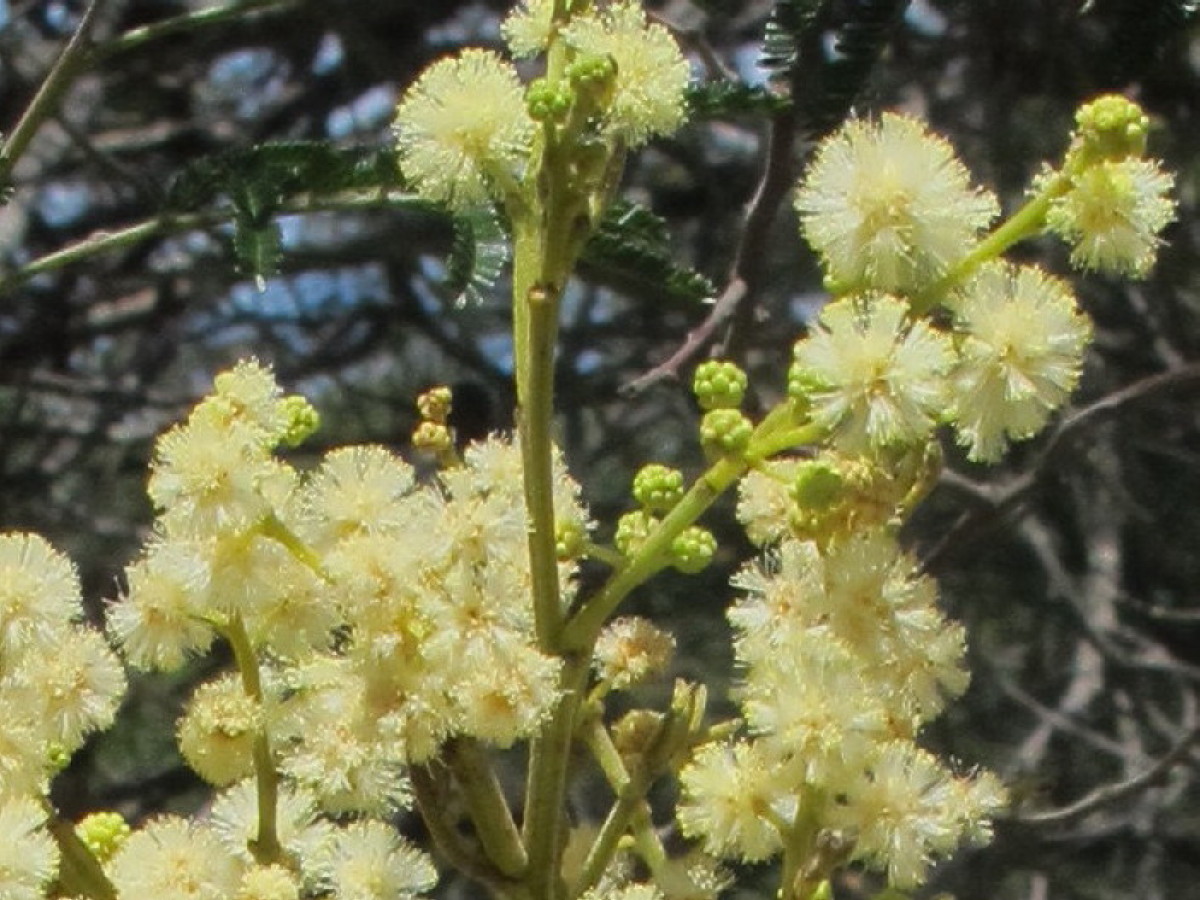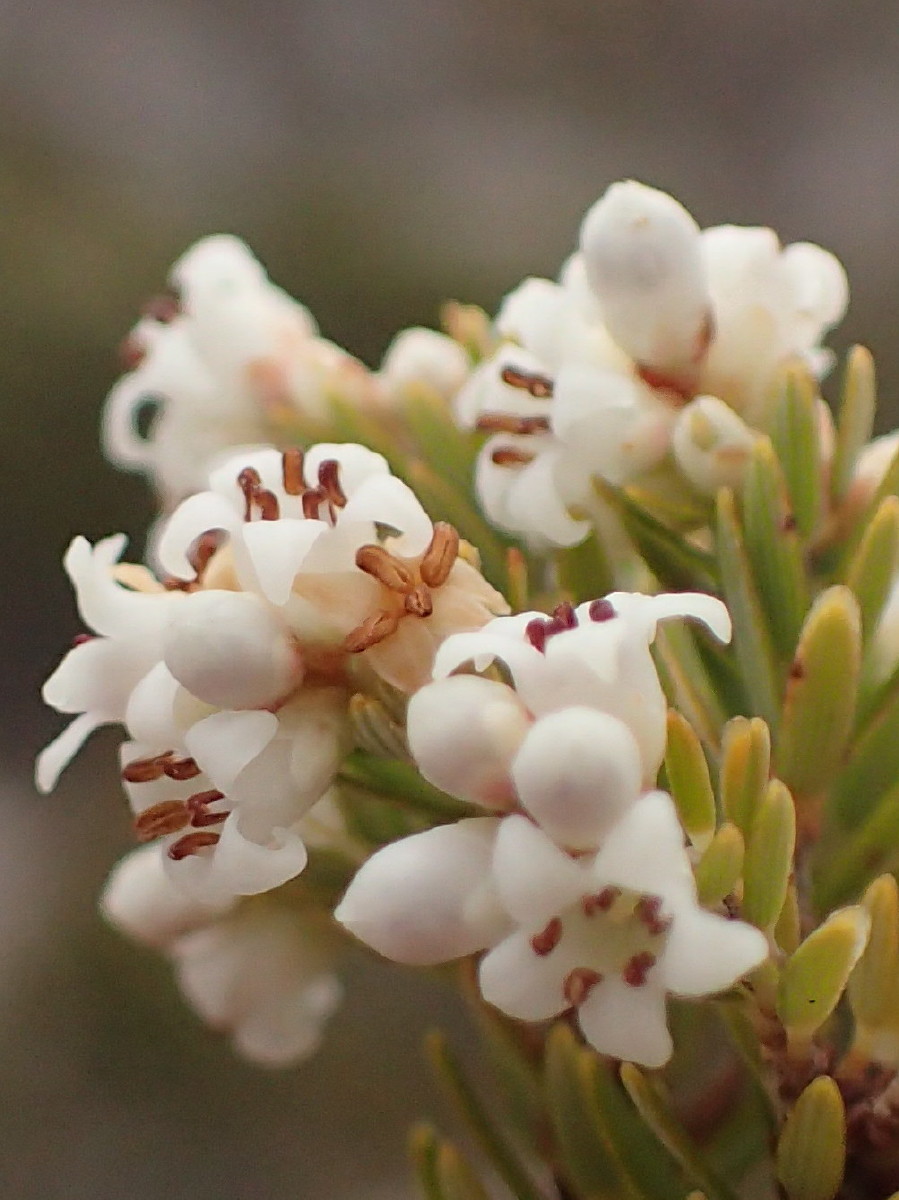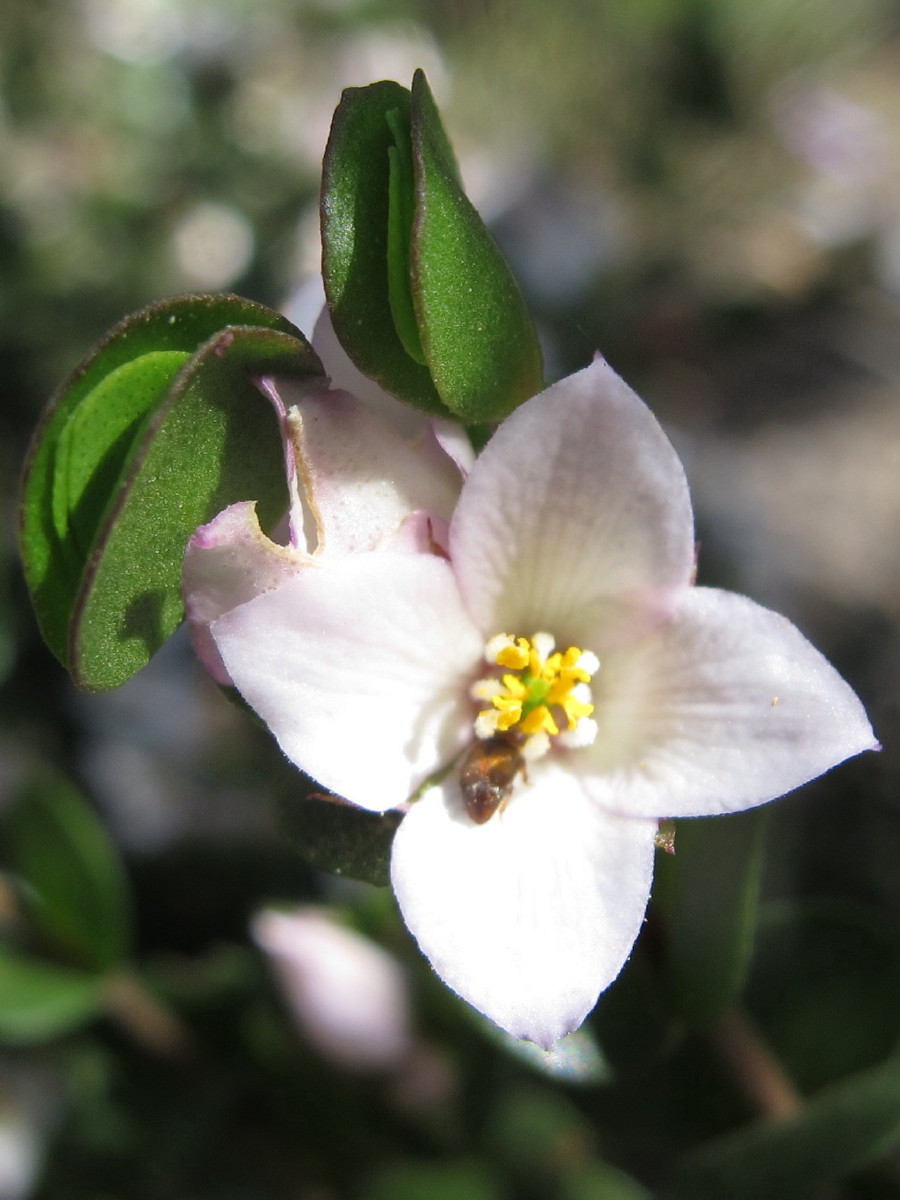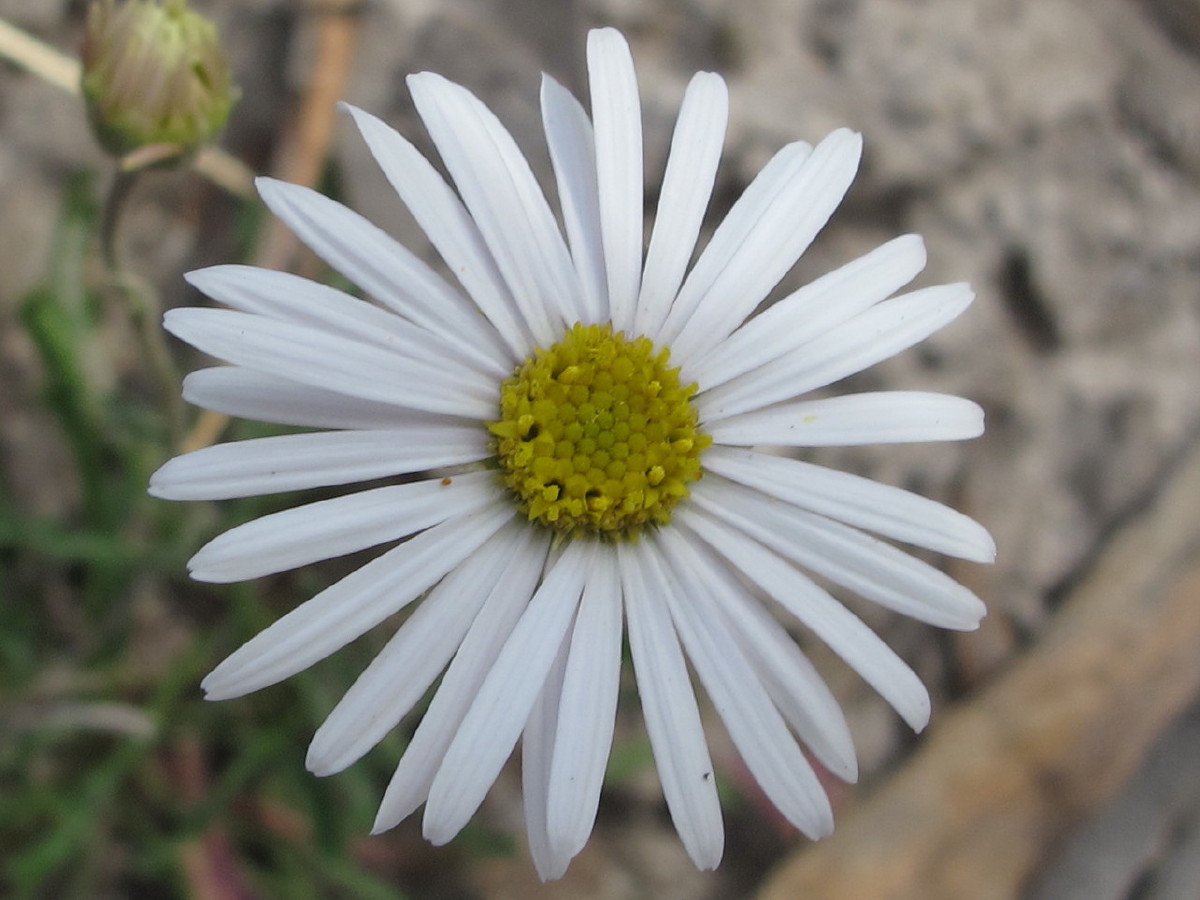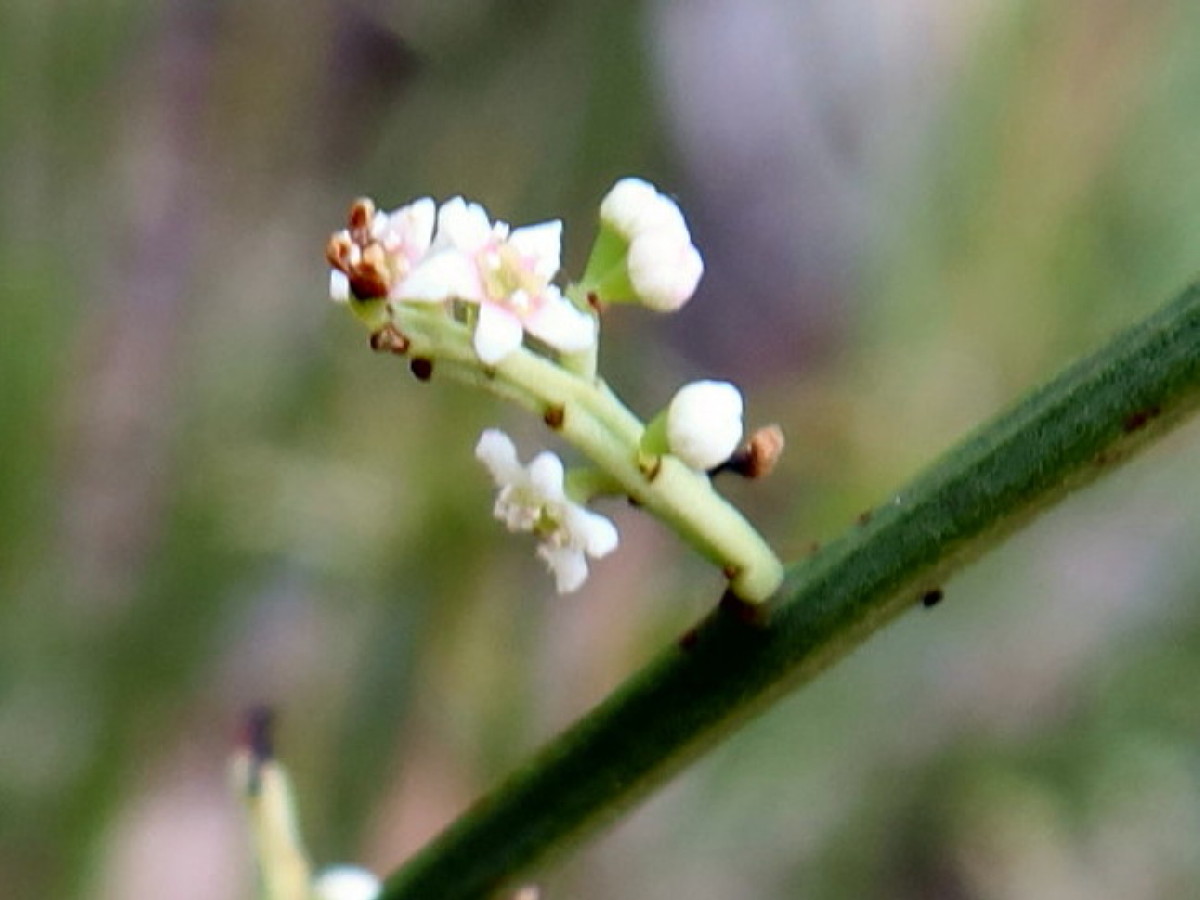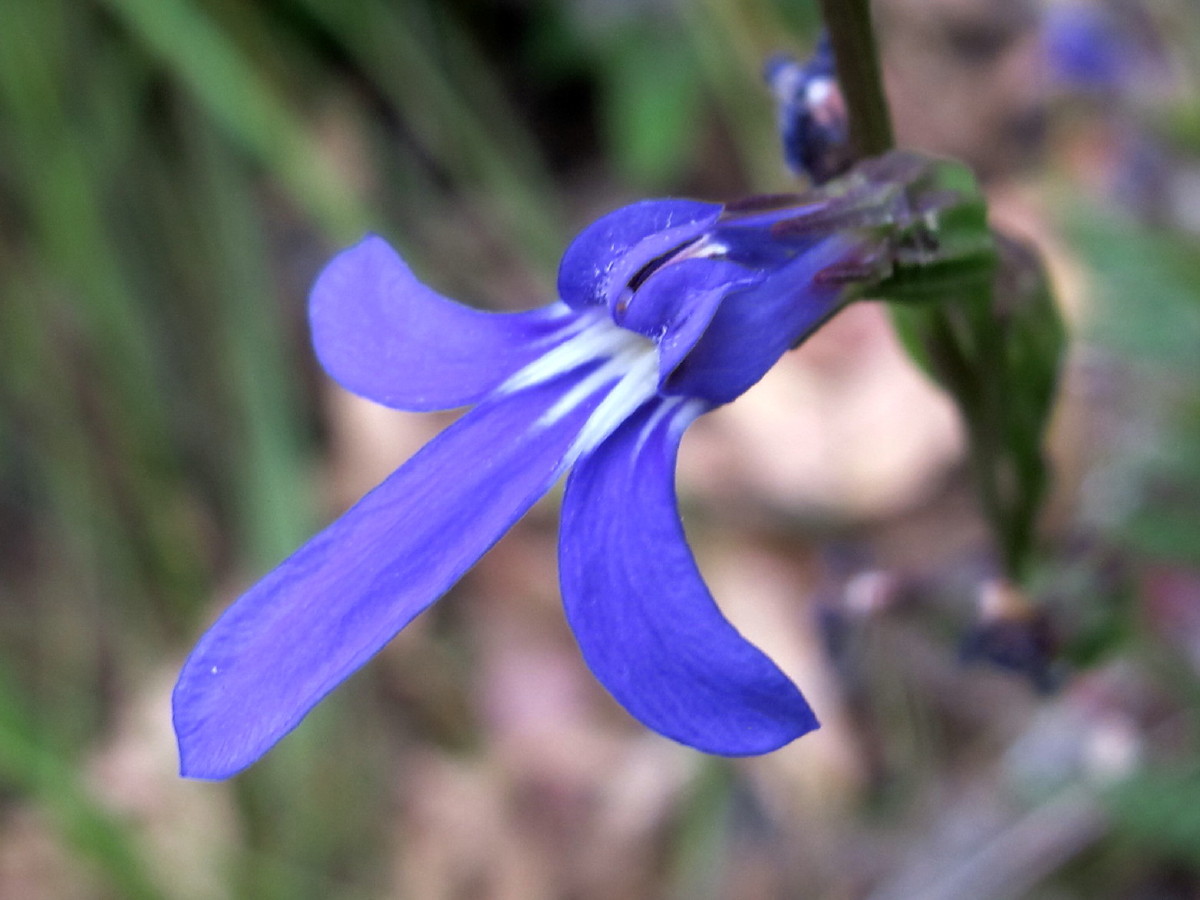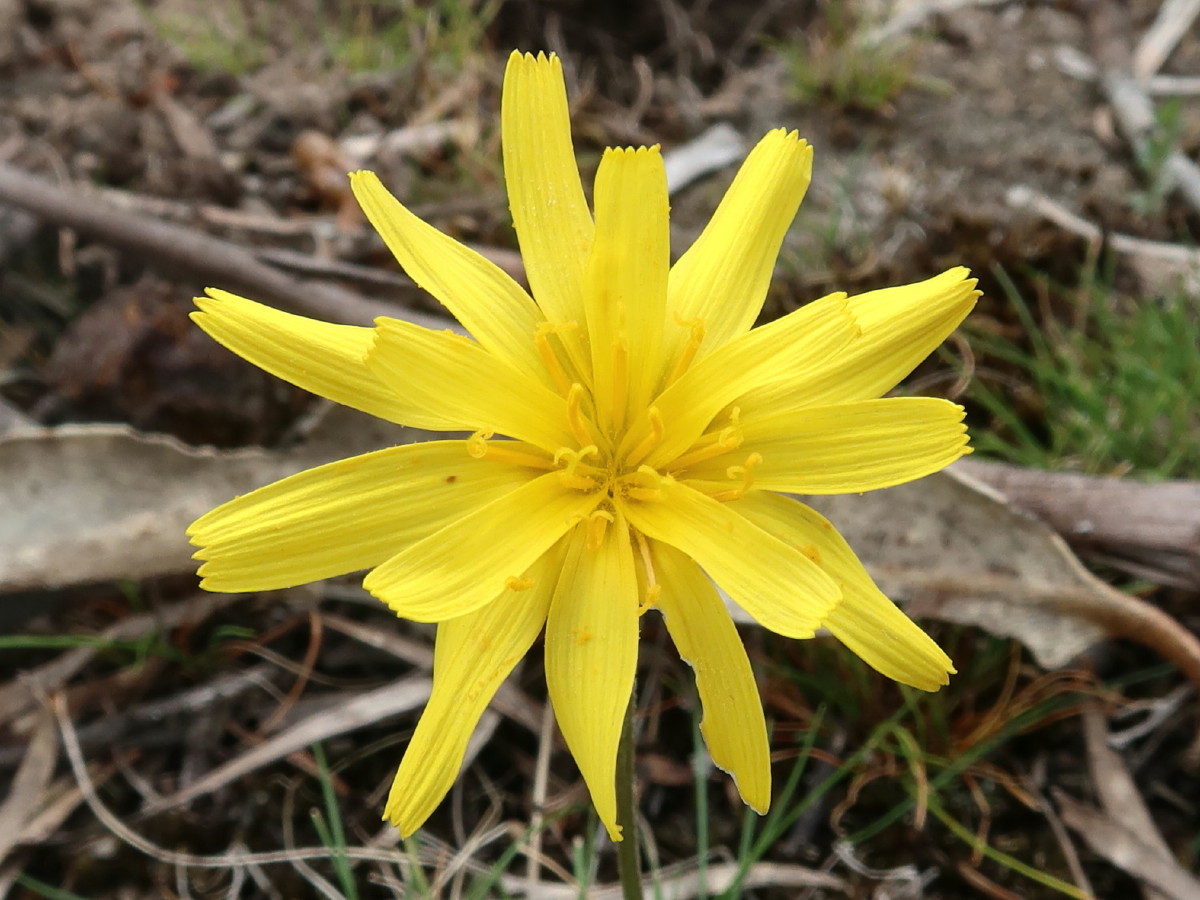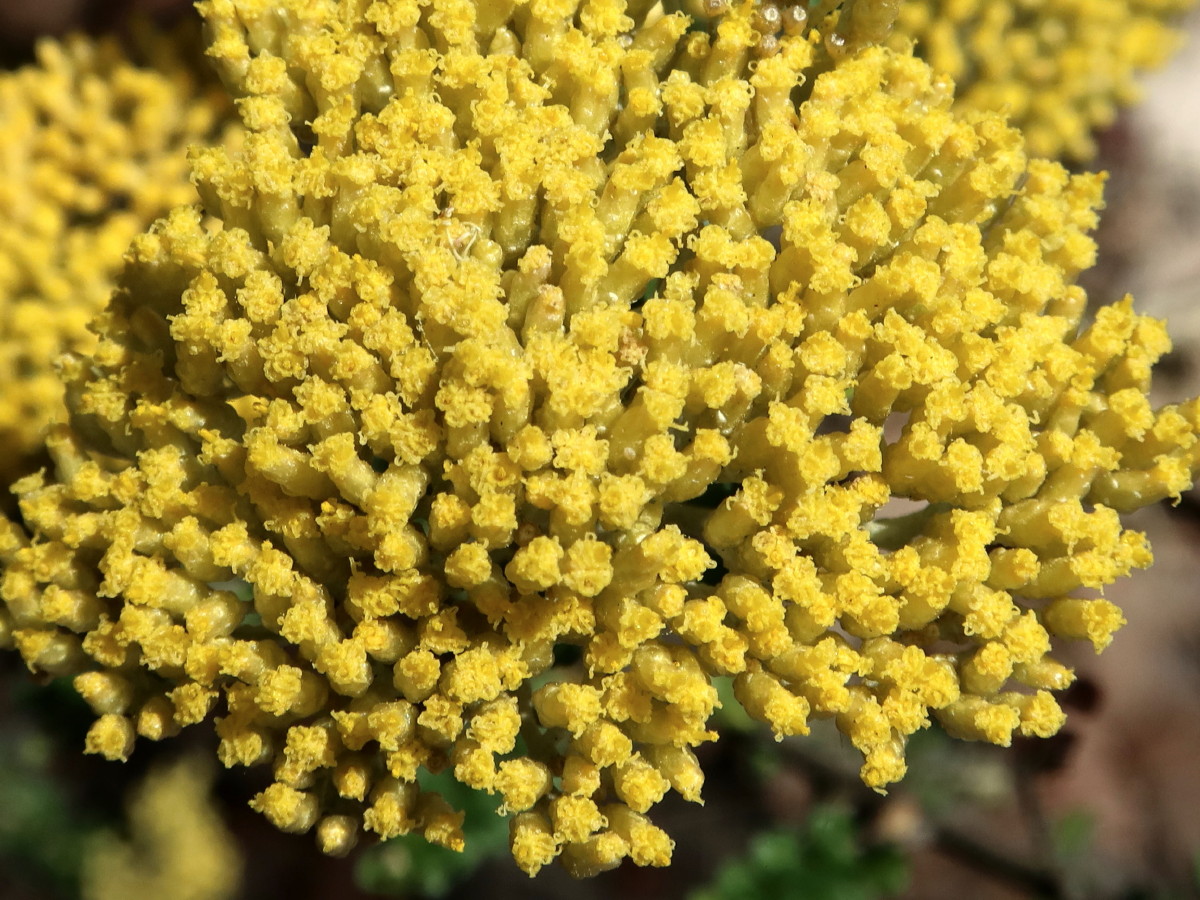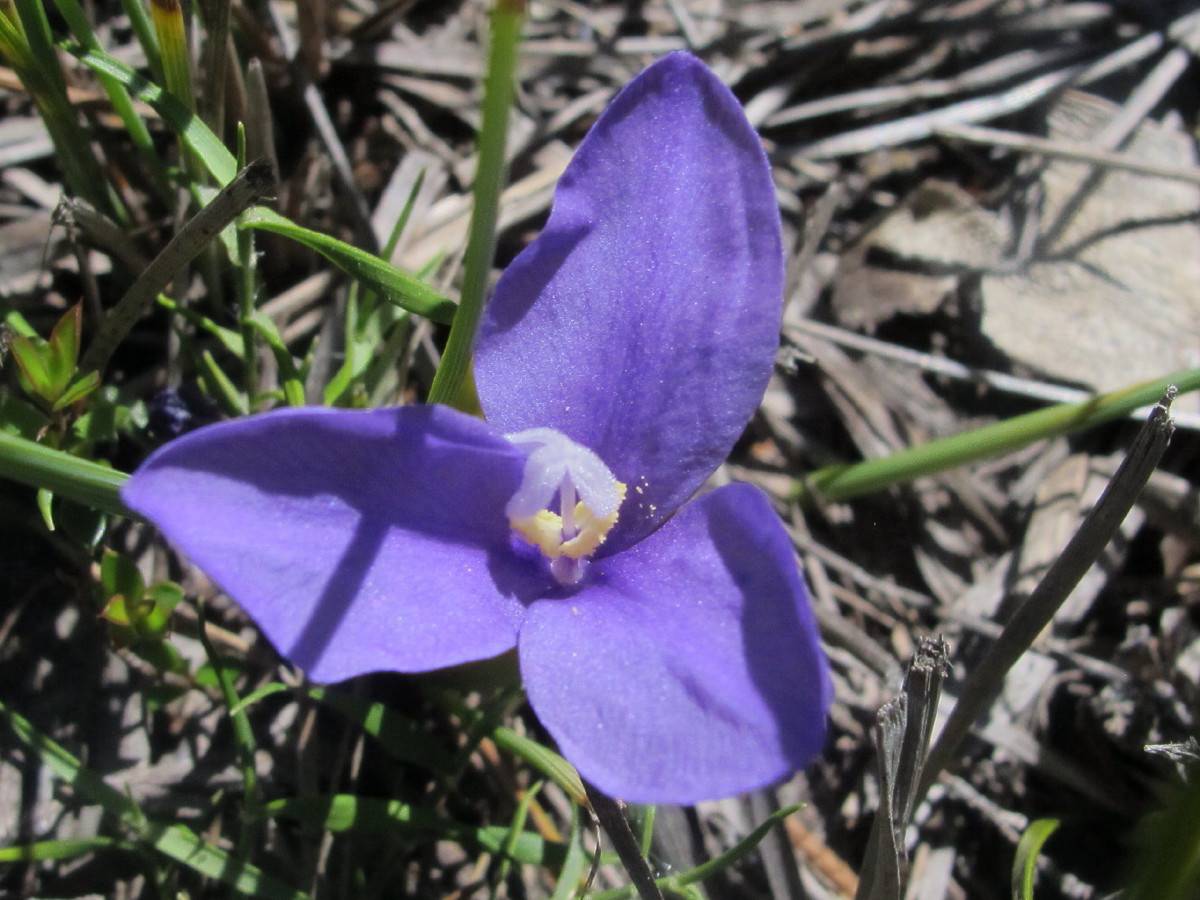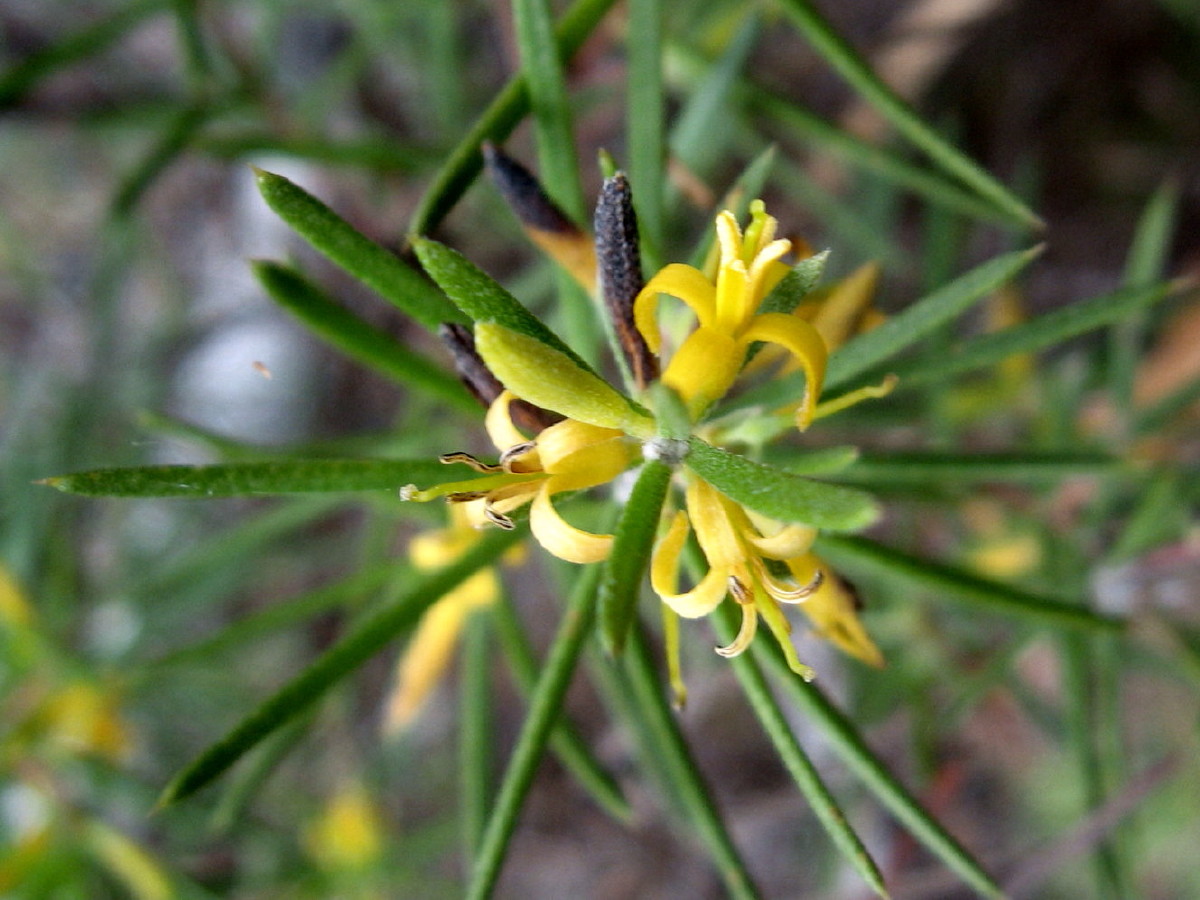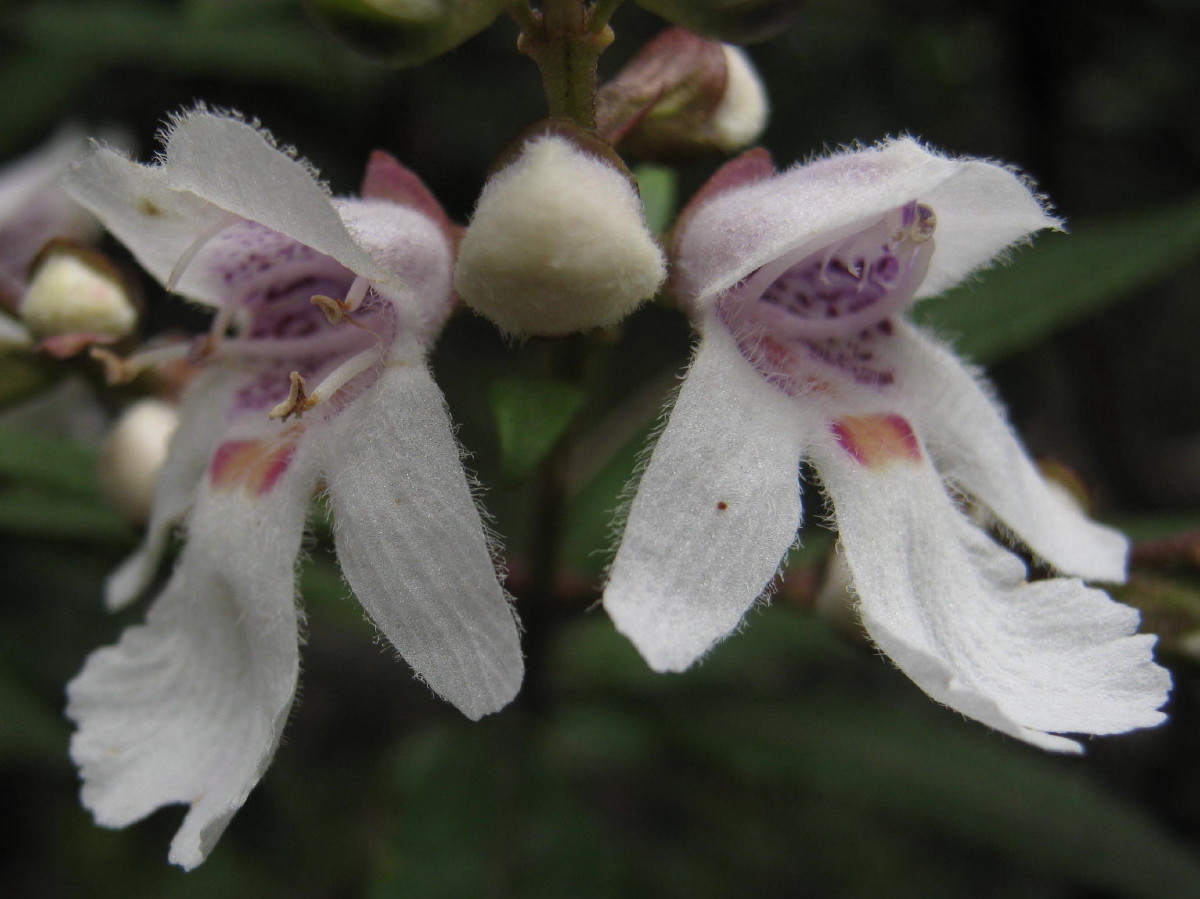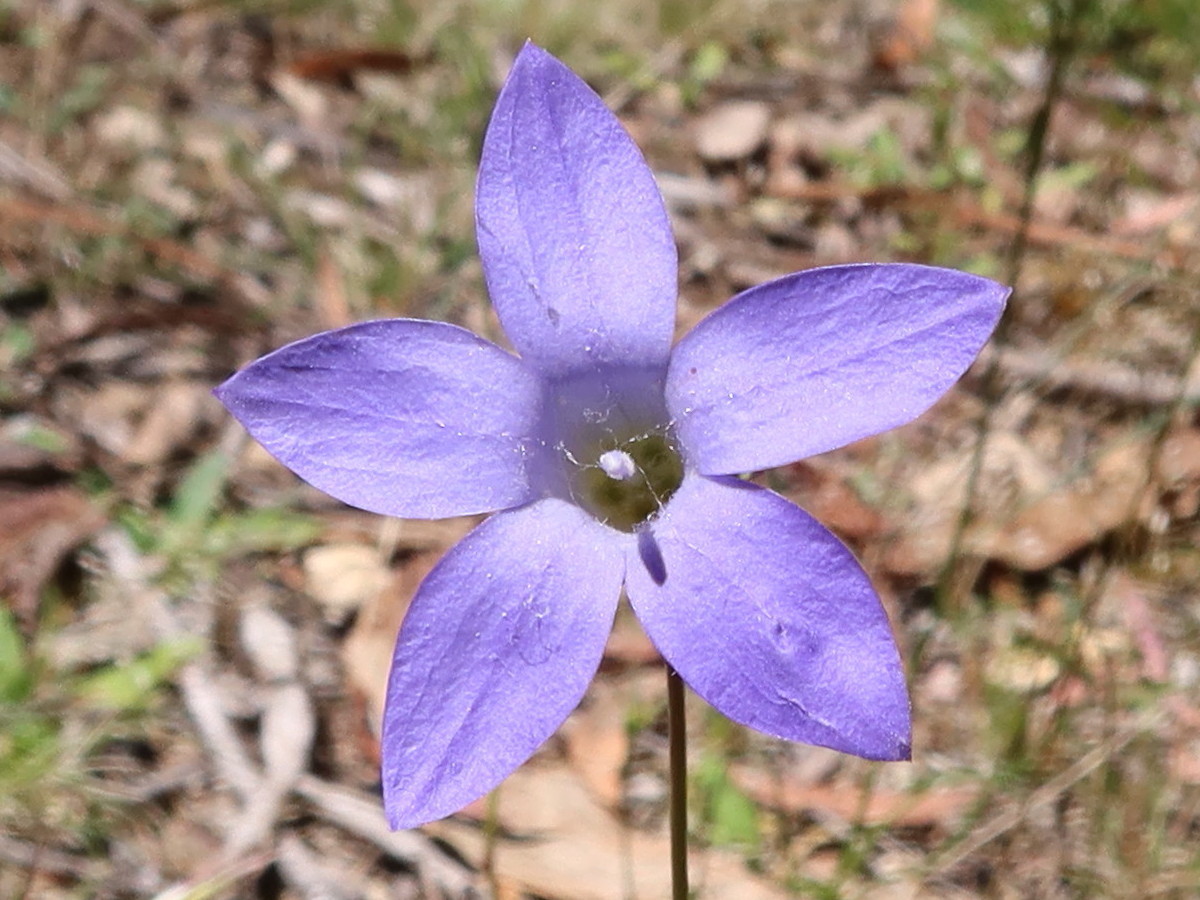Summer
Looking at the photographs To view the photographs, click on the species image to enlarge it,
then use the side arrows to page through images of the flowers, buds, fruit, leaves, foliage and plant(s) in the wild etc.
Viewing the meaning of botanical words To view the meaning of botanical words, hold the cursor on the blue word and the meaning will appear in a text box. On phones, turn to landscape to view all.
Based on Debenham C’s, The Language of Botany, A Publication of The Society for Growing Australian Plants, Chipping Norton NSW, c.1962.
Acacia mearnsii
Botanical Name: Acacia mearnsii
Commonly Called: Black wattle
Botanical Family: FABACEAE subfamily MIMOSIODEAE
Grows: This wide-spread tree with dark grey bark grows typically 7 to 10m high by 6 to 8m wide.
Foliage: The branchlets are pubescent, as are the leaves. These bipinnate leaves are initially golden bronze colour maturing to dark dull olive green and are up to 20cm long. The leaves have 12 to 18 pairs of 2.5 to 4cm long pinnae on angular stems. Each pinna has a large number of linear, blunt, less than 4mm long leaflets. Raised glands occur on the upper side of the rachis at and between each pinnae pair.
Flowers: The flowers form in globular heads, up to 8 mm diameter, each with as many as 40 very small staminate, pale yellow or cream coloured flowers. The stamens produce the well recognised pollen, while the numerous female flower carpels capture pollen grains in their stigmas to sometimes fertilise their ovules. The heads, on hairy peduncles 2–8 mm long, are arranged in axillary and terminal panicles or racemes.
Flowering Season: The fragrant flowers appear in November but mainly bloom in December. Acacia mearnsii is the only tree form Tasmanian acacia which is flowering at this time of the year. The majority of others flower in late winter to early spring.
Fruit: The fruit are large flat pods, up to 10cm long by up to 1cm wide, blue/green when forming, then maturing to dark brown. They are constricted between the several seeds.
Habitat/distribution: This species tolerates a wide range of soil types but prefers moist soil in dappled shade, partial or full sun. It is common in Tasmania in the south east, mid-east coastal and upper midlands. It also grows in many places in SA, Vic. and NSW.
Where found: It has been recorded and/or found in: Big Punch Bowl and Long Point and Little Swanport Tasmanian Land Conservancies properties; Narawantapu and Forestier and Tasman Peninsulas in Tasman National Parks; Lauderdale to Cremorne Coastal Track, Knocklofty, Meehan Range Nature Recreation, Mortimer and Ralphs Bay, Old Convict Road & Orford Probation Station, Peter Murrell and Wingara Gully Reserves; and other bushland parks and gardens.
Other notes: This fast growing acacia is ideal for shelter belts and in its preferred moist locations the dense foliage can provide good shade. It is a good species for disturbed area erosion control and can withstand light frosts and occasional dry periods. Acacia mearnsii is often invaded by large caterpillars possibly of the Endoxyla encalypti, Large wattle goat moth, species. Yellow tailed Black cockatoos hear the caterpillars chewing the trunk’s wood and internal tissue and rip off the old bark with their strong beaks to extract the caterpillars. The species is easily propagated from hot water treated seed. The multiple glands along the rachis and the dark dull olive green leaves distinguish this species from Acacia dealbata and Acacia terminalis.
Acrothamnus montanus
Botanical Name: Acrothamnus montanus
Commonly Called: Snow beardheath
Botanical Family: Epacridoideae Tribe 6 Stypheliae
Grows: This small, pretty, white flowering, woody, erect shrub has fruit which may persist all summer.
Foliage: This species has 4 to 10mm long, pointed, stem-clasping, alternate leaves. Their upper surface is green and their lower surface is grey with several parallel veins.
Flowers: The tubular, unisexual, white flowers, with hairless lobes, grow in terminal clusters.
Flowering Season: The flowers appear in summer.
Fruit: The fruit is a 2 to 3mm diameter white to red persistent drupe.
Habitat/distribution: This species is wide-spread in elevated areas of sub-alpine grassy heathlands and open sclerophyll woodlands throughout the state. It also grows in NSW and Vic.
Where found: It has been recorded and/or found in: Cradle Mountain Lake St Claire National Park (NP); Urquhart Track and other locations in Mount Field NP; Thark Ridge and Zig Zag Tracks, kunanyi/Mount Wellington; and possibly some high elevation home gardens.
Other notes: This attractive, pretty white heath shrub with decorative fruit, although not widely grown, is suitable for rockeries and plant pots. It requires moist soil with good drainage. Propagation is from seed or by tip cuttings. Its beardless, floral-tube lobes distinguish it from Acrothamnus hookeri.
Argentipallium dealbatum
Botanical Name: Argentipallium dealbatum
Commonly Called: White everlasting
Botanical Family: Asteraceae
Grows: This pretty white flowering daisy with basal leaves may have several flowers along a rhizome.
Foliage: This species has a basal cluster of, upper surface dark green and white-hairy lower surface, elliptical leaves and several pubescent light green stem leaves.
Flowers: The solitary, terminal flower head involucre, 1.2 to 2.2cm diameter, grows, as the flower develops, on an increasingly taller, erect, tomentose peduncle up to 10cm high. There are multiple layers of ray florets the outer ones are short, acute and brown or reddish, the intermediate ones are spreading and have a short broad claw and a white narrow lanceolate blade. The inner ones are similar but shorter. The numerous yellow, tubular florets are scarcely one-third as long as the ray florets.
Flowering Season: The flowers appear in later spring but mainly bloom in summer.
Fruit: The fruit is a cypsela with pappus-bristles minutely barbellate and slightly thickening toward the apex.
Habitat/distribution: This species is wide-spread but more common in moist peaty soils. It is common in Tasmania in the south east, also the east, north-east and northern coastal areas, a few places down the west coast and throughout the centre of the state. It also grows in Vic.
Where found: It has been recorded and/or found in: The Tarkine; Tasman Peninsula in Tasman National Parks; Hawthorn Drive, Maranoa, Kingston; Meehan Range Nature Recreation, Cambridge; Knocklofty, Cambridge and Peter Murrell, Blackmans Bay Reserves; and other bushland parks and some home gardens.
Other notes: This pretty white daisy is ideal for rockeries and plant pots. It requires summer moisture and full sun but flowers longer with afternoon shade. Propagation is by seed or basal cuttings. Its distinguishing features are its red buds and silvery white under leaf.
Arthropodium milleflorum
Botanical Name: Arthropodium milleflorum
Common Name: Pale vanilla-lily
Family: Liliaceae
Size: This small clumping species grows 30 to 50cm high by 5 to 30cm wide.
Leaves: The soft, dark green/greyish, strap-like leaves taper to a fine point. They are 3 to 40cm long by 1 to 2cm wide, and are often persistent.
The flowers: The pale blue, purple or white, single or clusters of flowers, with densely bearded filaments, hang from nodes along 50cm long leafless stems.
Flowering Time: The flowers appear in late spring and continue through summer.
Fruit: The fruit is a capsule.
Habitat/distribution: This pretty plant grows on dry rocky slopes with light forest cover in altitudes up to 800m. It also is indigenous in SA, Vic and NSW.
Where to See: It may be found in Diprose Lagoon Nature, Peter Murrell, Orford Thumbs and Township Lagoon Reserves; Tasman National Park; the Luther to Stapleton Points Track, Orford; and Wingara Gully Howden.
Other notes: This tufted perennial herb has fibrous and tuberous roots which usually grow away from the crown. It features up to 4 flowers on jointed stalks arising from each node on the stem.
Boronia rhomboidea
Botanical Name: Boronia rhomboidea
Commonly Called: Broadleaf boronia
Botanical Family: Rutaceae
Grows: Usually a small, prostrate or erect, subalpine shrub growing 20 to 75(-100)cm high by 50 to 100cm wide. However, a small population was growing on the western side of Abelia Drive, Longley until the vegetation was slashed in about 2020 and the plants died.
Foliage: The branches may sometimes be slightly glandular tuberculate. The (3-)5 to 13mm long (1-)5 to 15mm wide leaves are broad ovate to nearly circular or rarely obovate, and glabrous or ciliate possibly only at the base, arranged alternately along the branches.
Flowers: The 4-petalled flowers with 1 to 3.5mm long pedicels grow in terminal and/or axillary groups of 1 to 3 on 0 to 2mm long peduncles, with elliptical or oblong glabrous or sparsely ciliate sepals 2.5 to 3.5mm long. The white to pink, glabrous petals are 5 to 8mm long. The staminal filaments are also glabrous as is the gynaecium, and the stigma is minute.
Flowering Season: The flowers may be seen from mid-spring to the end of summer, even early autumn.
Fruit: The fruit is a small four-celled capsule.
Habitat/distribution: This species is found to be locally dominant when growing in alpine and subalpine heath and sedgelands, also in Eucalyptus woodlands, mainly at higher altitudes in the northern part of the Central highlands. It is also found in isolated clusters near Mathinna, Vale of Rasselas, Gog Range, Gordon Plains, and possibly some plants still exist in the Longley site. It is also found in NSW.
Where found: Dove River and Overland Track near Crater Lake, also several other locations in Cradle Mountain Lake St Claire National Park; Gowrie Park area, Main Road/Tea Tree Road; Jubilee Range; Mt Pelion; Mt Roland, near the summit; Royal Tasmanian Botanical Gardens; and The Tasmanian Arboretum, Eugenana; also a few home gardens.
Other notes: This small spreading shrub at low altitudes prefers semi shade and at higher altitudes full sun. This delightful plant very suitable for rockeries. Moist free draining soils are required. Propagation is not easy and cuttings may be slow to strike. The rhomboid shaped leaves are the distinguishing feature.
Brachyscome aculeata
Botanical Name: Brachyscome aculeata
Commonly Called: Hill daisy
Botanical Family: Asteraceae
Grows: This bright, white-flowering, perennial, herbaceous daisy with variable features sometimes has multiple flower stems.
Foliage: The flower stems are leafy, stem clasping at the base and branched further up. The hirsute basal leaves, 2.5cm long by 3 to 5mm wide, are oblanceolate or narrow-cuneate and irregularly toothed toward the tip. The smaller upper leaves are less deeply toothed.
Flowers: The 8 to 15mm diameter involucre surrounds narrow-spathulate phyllaries with scarious margins which are often wide at the apex. Their outer surface is glandular-pubescent and more or less hirsute. The ray-florets with 6 to 10mm long ligules are white or occasionally bluish.
Flowering Season: The flowers may be seen from mid-spring to the end of summer, even early autumn.
Fruit: The fruit are somewhat flattened, obovate, winged achenes, the faces of which are glabrous or with a few tiny glandular hairs. The irregular pappus bristles tend to be broad and scale-like at the base and as long as the notch between the wings.
Habitat/distribution: This species is widespread and frequent especially on dry hillsides. It is also found in SA, Vic, NSW and Qld.
Where found: Big Punch Bowl and Long Point, Tasmanian Land Conservancy Reserves; Cambridge Street, Cheltenham, Knocklofty, Peter Murrell, Tom Gibson, and Winifred Curtis Scamander Reserves; Tarkine area; Mt Field and Tasman National Parks; kunanyi/Mt. Wellington; Brown Mountain Runnymede southern access trail; Cross Rivulet track up to Craigow Hill, Meehan Range; Gunners Quoin (summit) Reserve access track; East Gellibrand Drive, Silver Peppermint, Storm Bay View Tracks of the Tangara Trail Network, Sandford; Royal Tasmanian Botanical Gardens; and The Tasmanian Arboretum, Eugenana; Tasmanian Bushland Gardens, Buckland; and many other places, also some home gardens.
Other notes: This pretty white or bluish daisy grows well in full sun to semi shade and can survive extended wet periods. It is very suitable for rockeries where moist free draining soils are required. Propagation is from seed or division. The slightly hairy leaves and the white to bluish daisy flowers are the distinguishing features.
Bursaria spinosa
Botanical Name: Bursaria spinosa
Commonly Called: Prickly box
Botanical Family: Pittosporaceae
Grows: A tall shrub growing 3 to 5m high by 2 to 3m wide.
Foliage: The leaves are bright glossy green above lighter below, blunt wedge-shaped, arranged alternately along the branches. Spikes also grow along the branches and on the tip of branchlets.
Flowers: The 5-petalled white, star-shaped flowers have central protruding stamens. The flowers are arranged in a terminal pyramid.
Flowering Season: The flowers brighten the bush during summer.
Fruit: The fruit is a bilobed, flat, heart-shaped capsule.
Habitat/distribution: This species is widespread, common in coastal sandy gravel areas, extending inland to wet sclerophyll. It is also found in WA, SA, Vic, NSW and Q.
Where found: Most National Parks; Wellington Park; Knocklofty and Coningham Reserves; Royal Tasmanian Botanical Gardens; Tasmanian Bushland Garden, Buckland; and The Tasmanian Arboretum, Eugenana; also many home gardens.
Other notes: Woody shrub to small tree with the smaller branches and side stems ending as spikes. The horticultural potential of this plant lies in its ability to attract bees, butterflies and birds with its sweet-scented flowers.
It is also a good coastal revegetation plant and can be trimmed to a hedge. This compact, dark green shrub with masses of white summer flowers usually humming with bees, and heart-shaped fruit make it easily recognised in the bush or garden.
The sharp spikes on its branchlets make it a safe haven for small nesting birds which have been known to use white domestic hen feathers to line and camouflage their nests during flowering time.
Chrysocephalum semipapposum
Botanical Name: Chrysocephalum semipapposum subsp. semipapposum
Commonly Called: Clustered everlasting
Botanical Family: Asteraceae
Grows: 20-90cm H x 40-90cm W
Foliage: Crowded, small, narrow linear, green to silvery grey, hairy, on side stems, sometimes sticky.
Flowers: Terminal, bright yellow in dense flattened clusters.
Flowering Season: Flowers may be seen during spring through summer.
Fruit: An achene.
Habitat/distribution: Widespread and common in open grasslands. Also SA, Vic, NSW.
Where found: Saltwater River area on Tasman Peninsula, Derwent Valley areas: Meadowbank Dam Road, Macquarie Plains, New Norfolk; Black Hills Church and Cemetery Reserve, Braslins Road, Black Hills; Sky Farm, Glenorchy; Windermere Bay, Claremont; Knocklofty Reserve; East Risdon Nature Reserve; Caves Hill, Meehan Range;
Grasstree Road, W of Back Tea Tree Road; Near Tunnack; Bluff River Gorge; Shannon River downstream of Hermitage; Lakes Highway 15km N of Bothwell; Gangells Road, Bagdad; Perth Nursery, Picnic Point; Slopes above South Esk, Native Point; Watery Plains, Launceston;
Township Lagoon Nature Reserve; Kingston via Conara; Avoca; Buckland; Royal Tasmanian Botanical Gardens; and Tasmanian Bushland Garden, Buckland; also some home gardens and other locations.
Other notes: An upright variable perennial herb with flattish topped clusters of bright yellow flower heads on erect stems compared to the rounded golden flower heads of Chrysocephalum apiculatum. A hardy plant for dry areas in full sun. Prune to ground level after flowering to promote growth from the woody rhizome.
Coronidium scorpioides
Botanical Name: Coronidium scorpioides
Commonly Called: Curling everlasting
Botanical Family: Asteraceae
Grows: 10-80cm H x 50-75cm W
Foliage: Crowded at the base, more widely spaced on the flower stem, grey-green, soft, usually cottony hairs on both surfaces.
Flowers: Solitary yellow flower heads, 2 to 3cm across, the central part surrounded by curled papery bracts.
Flowering Season: Late spring/summer.
Fruit: An achene.
Habitat/distribution: Widespread in understorey in a variety of habitats from sea level to alpine. Also SA, Vic, NSW.
Where found: Throughout Tasmania: Cradle Mountain & Lake St Clair, Hartz, Mt Field, Rocky Cape, South West and Tasman National Parks; King and some Furneaux, Maria and Bruny Islands; Bluff River Gorge, Bridport Wildflower, Cheltenham , Orford Thumbs, Peter Murrell, Meehan Ranges, Wellington Park and many other Reserves;
Heritage Forest Tasmanian Native Garden; Royal Tasmanian Botanical Gardens; Tasmanian Bushland Garden, Buckland; and The Tasmanian Arboretum, Eugenana; also many home gardens.
Other notes: A stoloniferous perennial herb with conspicuous, solitary yellow daisy flowers with curling papery phyllaries (bracts). A hardy spreading ground cover. Prune after flowering to maintain carpet effect.
Dianella tasmanica
Botanical Name: Dianella tasmanica
Commonly Called: Forest flaxlily
Botanical Family: Liliaceae
Grows: 50-150cm
Foliage: The leaves are broad, linear, strap-like and Y-shaped in cross section to 1m long. They are distinctly serrated along the edges and undersurface of central veins.
Flowers: The flowers are loosely clustered on long stalks with strong many branched stems. They have 6 small white or mainly blue petals and prominent yellow stamens.
Flowering Season: The flowers appear in spring and summer months.
Fruit: The fruit are blue to purple shiny berries, containing many black seeds.
Habitat/distribution: This species is wide spread from coast to 800m as a common understorey plant in wet sclerophyll and rainforests. It is also found in Vic and NSW.
Where found: Throughout Tasmania especially in shady moist positions. Bass Strait, Maria and Bruny Islands; Ben Lomond NP entrance, Cradle Mountain/Lake St Claire, Mt Field, Narawntapu, Rocky Cape and Tasman National Parks;
Bluff River Gorge, Bridport Wildflower, Knocklofty, Orford, Peter Murrell, Wellington Park, Wielangta Forest and many other Reserves; many other places such as Cockle Creek, Dunbarton, Mole Creek area, McKays Road near Lake Leake Rd Swansea area, Tullah area and Pieman River near Smithton; Heritage Forest Tasmanian Native Garden, Royal Tasmanian Botanical Gardens, Tasmanian Bushland Garden Buckland and The Tasmanian Arboretum Eugenana; also many home gardens.
Other notes: A herbaceous perennial spreading by rhizomes and may form a dense clump. It has excellent horticultural potential and may be useful as a riparian or bank stabiliser due to the spreading rhizomes.
Dillwynia glaberrima

Botanical Name: Dillwynia glaberrima
Commonly Called: Smooth parrotpea
Botanical Family: Fabaceae
Grows: A colourful, small, pea flowering, open shrub which grows 1 to 1.5m high by 1 to 2m wide.
Foliage: The stems are glabrous or the younger stems and leaves are pubescent. These light green leaves with a groove on their top surface are 1 to 2cm long, filiform nearly terete, linear, some times spirally twisted with a recurved tip and crowded along the stems.
Flowers: The pea form flowers on short stems grow in racemes or, small clusters on very short or more than 2cm terminal or axillary stems. Sometimes the stems arise from a number of terminal axils forming a leafy corymbose panicle. The sepal lobes, 5 to 6mm long, are ciliolate. The deeply notched standard, 10 to 14mm wide is bright yellow with a red throat. The wings and the keel are also yellow.
Flowering Season: The flowers appear in late spring and summer months.
Fruit: The fruit an inflated pod about 10 to 12mm long.
Habitat/distribution: This species grows in a wide range of locations, mainly in wet heathlands around the coastal zone around the state. It is also found in SA, Vic and NSW.
Where found: Throughout Tasmania especially in partly shady, moist, well-drained positions. Flinders, King, and Schouten Islands, Freycinet, Narawntapu, Rocky Cape and Tasman National Parks; Hawthorn Drive, the Tarkine, Bridport Wildflower, Diprose Lagoon Nature, Peter Murrell and other Reserves; other places such as Tangara Axiom Track Acton Park and Glovers Bluff; Heritage Forest Tasmanian Native Garden, Royal Tasmanian Botanical Gardens and Tasmanian Bushland Garden Buckland and The Tasmanian Arboretum Eugenana; also some home gardens.
Other notes: This small open shrub prefers light shade and well-drained soil. It should be tip pruned after flowers have dropped or when stems get too long before the flowers form on the tips. It may be propagated from semi-hardwood cuttings or from seed.
Drymophila cyanocarpa
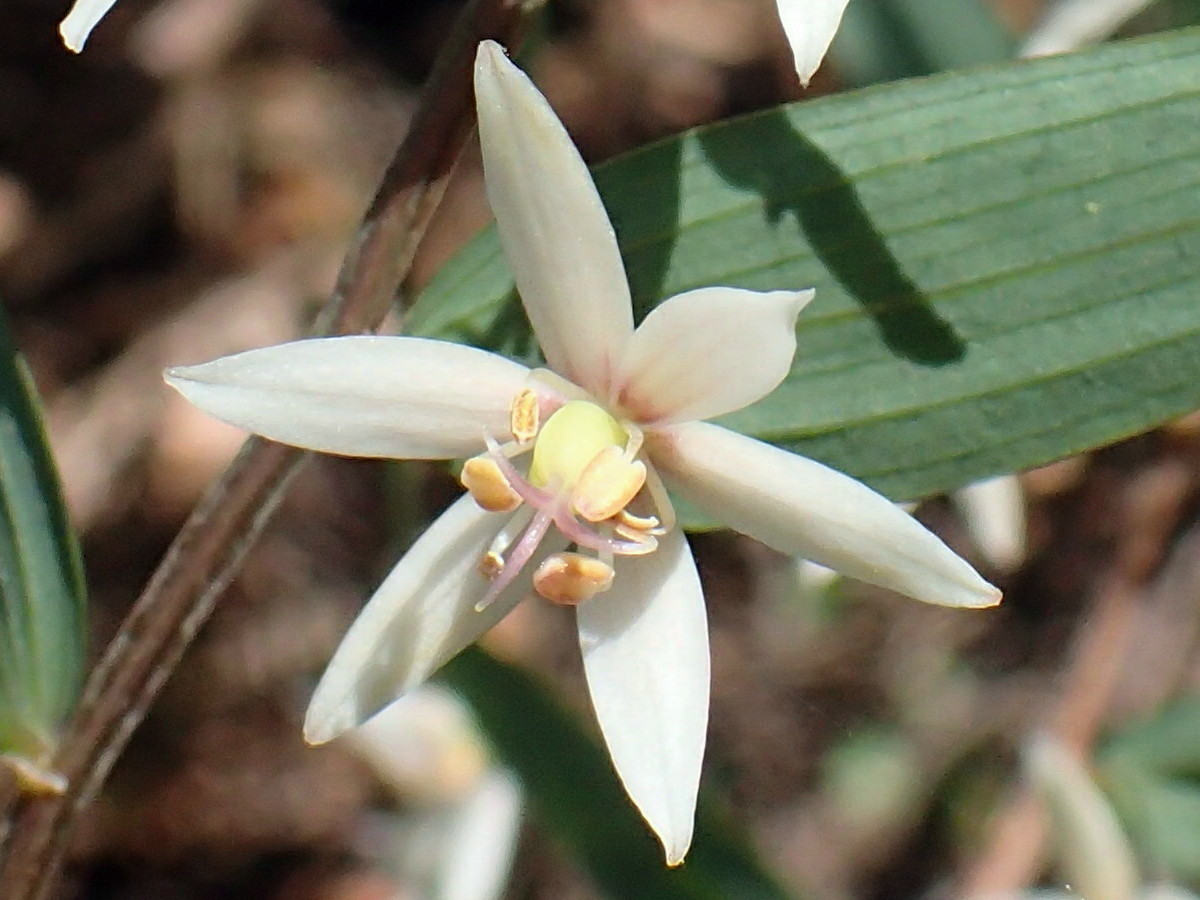
Botanical Name: Drymophila cyanocarpa
Commonly Called: Turquoise berry
Botanical Family: Liliaceae
Grows: A rhizomatous, small, perennial herb which grows 10 to 15cm high.
Foliage: The arching stem is sometimes branched and usually mottled purple-brown. The bright green, lanceolate to ovate-lanceolate leaves, with a prominent central and pairs of minor side divergent veins, are up to 8cm long and up to 15mm wide, distichous and petiolate.
Flowers: The solitary flowers on pedicels up to 13mm long are pendulous. The white perianth segments with 3 to 7 nerves, are up to 11mm long; outer ones are up to 1.5mm wide while the inner ones are up to 3mm wide. The anthers are about 1.5mm long and the filaments are up to 4mm long. The glabrous ovary is 2 to 3mm long and the three free divergent styles are 1 to 1.5mm long.
Flowering Season: The flowers appear in mid spring.
Fruit: The fruit is an ovoid to globular turquoise-blue berry 5 to 15mm long, with about 3mm long ovoid to oblong seeds.
Habitat/distribution: This species grows scattered but widespread, mainly in rain forest, wet sclerophyll and occasionally in drier forest from sea level to about 900m altitude. It is also found in Vic and NSW.
Where found: Throughout Tasmania especially in partly shady, moist, well-drained positions. It has been recorded or sighted on Bruny, Cape Barren, King and Maatsuyker Islands; in Cradle Mountain Lake St Claire, Hartz, Mount Field, Rocky Cape and Tasman National Parks (NPs); Greens Beach Conservation Area, Orford Thumbs, Peter Murrell, the Tarkine and other Reserves; many other places such as Mavista Nature Walk, Murrays Track, Tullah and Western Explorer areas, also possibly a few home gardens.
Other notes: This small, arching herb prefers shade and moist, well-drained soil but is difficult to keep alive. The arching stem with delicate, white flowers followed by turquoise-blue berries help to distinguish it from other small lilies. It may be propagated by division or from seed.
Eryngium ovinum

Botanical Name: Eryngium ovinum
Commonly Called: Blue devil
Botanical Family: Apiaceae
Grows: 40-70cm H x 40-80cm W
Foliage: The narrow, elliptical, variable leaves are 1 to 4cm long on a short stalk. They are dark green to grey on the upper surface and densely hairy undersurface with irregularly round-toothed or entire edges.
Flowers: The flowers are white maturing to bright metallic blue spiky heads.
Flowering Season: Flowers appear in summer.
Fruit: The fruit is a schizocarp and it ripens in autumn.
Habitat/distribution: Temperate woodlands and grasslands. Also WA, SA, Vic, NSW.
Where found: A few places, mainly in SE Tasmania: Lagoon Flats; Big Green Island, Bass Strait; Tasman Highway, Pontypool; near Boomer Creek, Little Swanport; Jim Bacon Memorial Reserve, Springfield, Moonah; Broadmarsh; Teatree Road, Brighton; Pontville Army Range, Brighton; Black Charlies Opening, Tasman Highway, Runnymede; Fulham Road, Dunalley; some other private properties.
Other notes: This species is listed as vulnerable under the Tasmanian Threatened Species Protection Act 1995. From the Listing statement for the species: it is a perennial species, dying down during autumn, emerging in late winter, and flowering in summer. In late winter the plant develops a rosette of narrow, spiny, divided leaves with the flower stems extending and producing a mass of crowded bright blue thistle-like flower heads on rigid branched stems in mid-summer.
The terminal flowerheads open first followed by those on the side branches below with each flower lasting several weeks (Ollerenshaw 1981). Best in fertile, heavy soils in sunny positions.
Eryngium vesiculosum
Botanical Name: Eryngium vesiculosum
Commonly Called: Prickfoot
Botanical Family: Apiaceae
Grows: These plants can grow from 30 to 60cm wide.
Foliage: The light green, rigid, sharply pointed leaves arise from a stem with flattened upper surface and rounded lower surface.
Flowers: The small flowers are oval to round in heads up to 1cm wide. They arise from the leaf axil in tight umbels with a very prickly bract under each flower head. The flowers are white maturing to blue.
Flowering Season: The flowers may appear in late spring but are mainly seen in summer.
Fruit: The fruit is a schizocarp.
Habitat/distribution: This species is widespread and common in moist coastal sand flats. It is also found in SA, Vic, NSW and Q.
Where found: Springlawn Lagoon, Narawntapu National Park; Flinders Island; Dago Plains, Circular Head; Discovery Beach, West Coast; Low Head, George Town; Latrobe; Near Campbell Town, Northern Midlands; Northdown wetlands near Far Lagoon; Musselroe Wind Farm, Cape Portland; Encampment Cove, Maria Island; Two Mile Beach, Bangor, Dunalley; Fulham Road, Dunalley.
Other notes: This is a compact, perennial, prostrate herb with blue flowerheads on a prickly plant usually in a swampy site. It may be short lived. It requires regular moisture and full sun and would make an attractive moist rockery or bog garden plant.
Euphrasia collina subsp. collina
Botanical Name: Euphrasia collina subsp. collina
Commonly Called: Tall eyebright
Botanical Family: Scrophulariaceae
Grows: This beautiful small plant grows 20 to 50cm high by 20 to 40cm wide
Foliage: The leaves are narrow, small, shiny and opposite with recurved margins and 1 to 3 lobes on the tips. They have a prominent central vein.
Flowers: Flower are white to shades of mauve, often with a purple throat.
Flowering Season: The flowers appear in late spring in lower altitudes, however, in higher altitudes they are mainly seen in summer.
Fruit: The fruit is a capsule.
Habitat/distribution: Widespread in a variety of habitats from sandy/peaty heaths to rocky hillsides and alpine grasslands on eastern mountains. They are also found in SA, Vic and NSW.
Where found: National Park; Knocklofty Reserve; kunanyi/Wellington Park along the Organ Pipes and Old Hobartians Tracks and above the Chalet, especially along the Thark Ridge Track.
Other notes: Small perennial, semi-parasitic herb with erect reddish flower stems. Leaves without hairs, calyx 5mm long, flowers never striated, growing in lowland areas and eastern mountains.
Hakea teretifolia
Botanical Name: Hakea teretifolia
Commonly Called: Dagger needlebush
Botanical Family: Proteaceae
Grows: This species is a small to medium, spreading, woody shrub with sharp leaves and dagger-like fruit. It grows 1 to 4m high by 0.5 to 2m wide.
Foliage: The leaves are rigid, narrow, and terete. They grow 2 to 4cm long and are arranged at right angles to the stem.
Flowers: The White, sweetly scented, spider-like flowers grow along the stems in terminal clusters or spikes.
Flowering Season: Flowers are seen throughout summer.
Fruit: Long, dagger-shaped, 2-seeded follicle, with a ring of sharp warts around the base of the long beak.
Habitat/distribution: Damp heathlands along the northern and eastern coasts. Widespread, especially in coastal heaths. Also WA, SA, Vic, NSW, Q, NT.
Where found: Narawntapu NP; Bridport Wildflower Reserve, St Helens area and many locations in the north east; Freycinet and Schouten Island, Forrestier Peninsula and near Orford, Tasman NP and throughout the Tasman Peninsula; and many other places in the south east; Royal Tasmanian Botanical Gardens; and Tasmanian Bushland Garden, Buckland; also some home gardens.
Other notes: It is very hardy, slow growing bush which tolerates dry conditions. Its sharp pointed leaves make it a barrier to people and animals and a good small bird nesting site. It grows in most well drained soils in full sun.
Hypoxis hygrometrica
Botanical Name: Hypoxis hygrometrica var. hygrometrica
Commonly Called: Golden weathergrass
Botanical Family: Hypoxidaceae
Grows: This delightful, yellow flowering species “keeps on keeping on!” with, in the right conditions, a new flower blooming for several days then some days later another new flower blooming for several days. It grows in a small clump with an up to 3cm long by 4 to 6mm wide, globular to cylindrical tuber.
Foliage: The sparsely pilose leave blades, up to 20cm long are generally conduplicate and up to 3mm wide when flattened.
Flowers: The bright yellow, 6 petalled flowers grow 1 to 3 per 2 to 20cm long stems which have a single 1 to 10mm long bract. The sepals are glabrous. There are 3 short and 3 long stamens and the anthers are 2 to 3mm long.
Flowering Season: Flowers are seen from late spring through summer.
Fruit: The fruit is an irregularly turbinate, thin-walled capsule up to 5mm long enclosing typically 4 weak walled cells within which are many black, shiny, ovoid to globular, about 1.75mm long seeds.
Habitat/distribution: This species is wide spread in coastal heathlands, sandy soaks, dry open forests and wet areas in rough pastures along the north west, north east and east coasts, midlands and the central highlands. It also grows in SA, Vic, NSW and Q.
Where found: Tiger Creek near Arthur River, Adventure Bay and airstrip Bruny Island, Bridport, Cape Grim, Cockle Bay Creek, Conical Rocks, near Garden Island Creek, Murdunna, Piccaninny Creek, Little Swanport, Southport, Uxbridge, Wineglass Bay; Cheltenham Reserve Maranoa Kingborough, Echo Sugarloaf Randalls Bay, Flash Tier Orford, Tinderbox Hills and, many other locations around the State, also some home gardens.
Other notes: This species may be difficult to establish and prefers to be undisturbed. It appears to be best propagated by direct sowing in small pots. Then, when roots show at the bottom, carefully remove the plant with the moistened soil plug from the pot and plant in the final location without disturbing the soil plug. Finally, backfill and water in. Plants may self seed given the right conditions, especially with regular overhead spray watering.
Lagenophora stipitata
Botanical Name: Lagenophora stipitata
Commonly Called: Blue bottledaisy
Botanical Family: Asteraceae
Grows: 5 to 15cm high by 5 to 15cm wide
Foliage: The basal rosette of lobed, spathulate leaves are green on top and purple underneath. Sometimes, elliptical to oblanceolate round tipped leaves, 2.5 to 5cm long by 0.5 to 1.5cm wide, develop up the flower stem.
Flowers: A solitary flower head, 4 to 10cm across, grows on a scape 5 to 20cm long. The ring of blue, mauve, pink or white, usually violet, ray florets surround the central, tubular disc-florets. These ray florets curl and sometimes darken as the flower ages. The cluster of disc-florets are bright yellow with pollen when the flower first opens. Then, as the flower ages and the pollen is collected or dispersed, the centre becomes darker and darker brown as the achenes develop.
Flowering Season: Flowers are seen during summer.
Fruit: The fruit are achenes which are somewhat bottle shaped, hence the common name.
Habitat/distribution: This pretty little daisy is widespread and frequent in a variety of habitats from sea level to over 1000m except down the west coast hinterland and mountain ranges, see distribution map. It is also found in SA, Vic, NSW and Q, and has possibly been recorded in tropical Asia.
Where found: Throughout Tasmania: Ben Lomond (inc. plateau), Cradle Mountain & Lake St Clair, Hartz, Mt Field, Narawntapu, Rocky Cape, South West and, probably, Tasman National Parks; King and some Furneaux, Maria and Bruny Islands; Bluff River Gorge, Bridport Wildflower, Cheltenham , Knocklofty, Orford Old Convict Road, Orford Thumbs, Mount Barrow, Peter Murrell, Meehan Ranges, the Tarkine, Wellington Park (probably) and many other Reserves and places around the state; also some home gardens.
Other notes: A small spreading rhizomatous herb with a conspicuous, solitary violet daisy flower. Prune after flowering to encourage spreading.
Leptomeria drupacea
Botanical Name: Leptomeria drupacea
Commonly Called: Erect currantbush
Botanical Family: Santalaceae
Grows: This hemiparasitic, much branched, shrub typically grows 1.0 to 2.5m high by 1 to 2m wide.
Foliage: The green flexible branches are nearly cylindrical and are ridged longitudinally. The sessile, scale-like and narrowly ovate to needle like leaves are 0.7 to 1.2mm long by 0.3 to 0.5mm wide and taper to an acute tip.
Flowers: The inflorescence is a raceme of typically 6 to 15, and as many as 25, bisexual flowers on a rachis 4 to 15, and as much as 47mm long, typically inserted laterally into the branchlets. The sessile, scale-like bracts are 0.7 to 1.2mm long by 0.3 to 0.5mm wide.
The 0.6 to 1.3 long tepals are white to cream, and when aging are often tinged red to pink. Their apex is incurved and prominently hooded. The deeply lobed floral disc is 0.6 to 0.8mm diameter and the anthers, filaments and style are typically 0.10- 0.15mm long.
Flowering Season: The flowers appear in late spring but mainly are seen during summer.
Fruit: The fruit is a greenish, white, fleshy, ovoid drupe with persistent flower remains, reddish and edible when ripe.
Habitat/distribution: This broom-like bush is found in all regions of Tasmania; widespread in heathlands, woodlands usually with a dense understorey, and open eucalypt forests. It is also found in far SE Vic, NSW and far SE Qld.
Where found: Bruny, Clarke, Flinders and Maria Islands; Freycinet, Narawntapu, Rocky Cape and Tasman National Parks; Bluff River Gorge, Bridport Wildflower, Cheltenham, Knocklofty, kunanyi/Wellington Park, Meehan Ranges,
Orford Thumbs and Flash Tiers, Peter Murrell, the Tarkine, Wingara Gully and many other Reserves and places around the state.
Other notes: The floriferous Leptomeria drupacea differs from Leptomeria glomerata by typically having 15 or more flowers on each rachis compared to 2 to 3 flowers for the latter species. It is typically found as an erect, light green, narrow stemmed shrub in light forest.
It can also be easily distinguished from the green/yellow flowering Exocarpos strictus by its cream to pink flowers and the shape of its fruit. Being hemiparasitic, it may be difficult to propagate, however, seed may be successful, possibly sown with a suitable host plant.
Field observation may assist in determining suitable host plants.
Leptorhynchos squamatus subsp. squamatus
Botanical Name: Leptorhynchos squamatus subsp. squamatus
Commonly Called: Scaly buttons
Botanical Family: Asteraceae
Grows: The sprawling small flowered daisy grows 10 to 20cm high and spreads up to 50cm.
Foliage: Lanceolate, 1-3cm long, hairy, alternate, at the base of the floral stem.
Flowers: Bright yellow, compact, button-like, terminal daisy.
Flowering Season: Spring/summer.
Fruit: An achene.
Habitat/distribution: Widespread, in a variety of habitats from dry coastal to elevated grasslands. Also SA, Vic, NSW.
Where found:; Big Punch Bowl and Long Point; Bridport Wildflower, Diprose Lagoon Nature, Knocklofty, Peter Murrell and Township Lagoon Nature Reserves; Rocky Cape, Freycinet and Tasman NPs; many places along the north, north east and east coasts; Heritage Forest Tasmanian Native Garden; Royal Tasmanian Botanical Gardens; Tasmanian Bushland Garden, Buckland; and The Tasmanian Arboretum, Eugenana; also many home gardens.
Other notes: Wiry stems with leaves only at the base. This small wiry herbaceous perennial plant is usually found in clumps. It prefers full sun and good drainage.
Lobelia gibbosa
Botanical Name: Lobelia gibbosa
Commonly Called: Tall lobelia or False orchid
Botanical Family: Campanulaceae
Grows: This pretty blue flowering herb grows 10 to 40cm high, with its slender stem or stems almost leafless as the flowers form.
Foliage: The stem or stems are often reddish and somewhat similar to a succulent. However, the lower half may become hard and dry even as the inflorescence develops. The 1 to 4cm long, lanceolate or linear-lanceolate, alternate leaves are few and distant and their edges are entire or with a few small teeth. The basal leaves are broader and smaller, and often wither before the flowers open.
Flowers: The inflorescence is a one-sided, terminal raceme. Sometimes the pedicels of the lower flowers are long. The approximately 3 to 4mm long sepals are narrow triangular. The deep blue or bluish-purple, variable in size corolla are often about 15mm long. The tube is almost as long as the sepals and its upper side is slit to the base. The recurved 2 upper lobes are scarcely as long as the tube while the 3 lower lobes are longer than the tube and spread in one plane. The narrow elliptical centre one is the longest and the lateral ones are falcate. The lobes are deep and bright blue while the tube and the throat of the corolla are pale greenish yellow. The anther-lobes are purple, each with a small tuft of hairs at the apex.
Flowering Season: The flowers can appear in late spring, but are mainly seen during summer and some may appear in early autumn.
Fruit: The fruit is an obliquely obconical capsule with a swollen upper side containing small seed.
Habitat/distribution: This species is widespread and locally frequent especially on sandy heaths and also on wet moors from sea level to altitudes of over 1000m. It is also found throughout temperate Australia.
Where found: It has been recorded in Ben Lomond and Tasman National Parks; and Knocklofty, Peter Murrell, takayna/Tarkine and Tom Gibson Reserves; Bruny, Cape Barren and King Islands; Boomer Marsh; Upper Gordon River; several locations up the Derwent River Valley; Tullah; near Renison Bell; Noahs Waterhole to Newtown Track – South Hobart, Government Hills – Geilston Bay, the Cape Pillar Track from Fortescue Bay – Tasman NP, western slope of High Yellow Bluff – Forestier Peninsula, Centennial Park Track – Mt Nelson, MacGregors Peak fire tower track – Forestier Peninsula, Pelverata Falls Track – Pelverata and, many other locations in Tasmania.
Other notes: This small annual herb relies on a specific mycorrhizal association for its growth. Therefore it is difficult to propagate and rarely grown in gardens. Its distinguishing features are the flowers arranged on one side of a leafless stem and the bright flower colour. Due to the flower form, it may be mistaken for an orchid.
Melaleuca gibbosa
Botanical Name: Melaleuca gibbosa
Commonly Called: Slender honeymyrtle
Botanical Family: Myrtaceae
Grows: This glabrous shrub grows 1 to 3m high with its slender branches spreading 1 to 2m.
Foliage: The crowded, opposite and decussate leaves are 2 to 7mm long, ovate to obovate, rigid, often sub-erect wit the upper part spreading or recurved..
Flowers: The sessile, pinkish-purple flowers in short ovoid heads, grow on lateral branches. Their stamens are arranged in five groups opposite the petals. The filaments of each group of stamens are joined at the base forming a flat claw which is free above, and the anthers are free to move around the filament.
Flowering Season: Some flowers open in spring, but most open in summer.
Fruit: The fruit are woody capsules which grow in close cylindrical spikes 1 to 2cm long at the base of the year’s growth of the branch.
Habitat/distribution: This species is found frequently in damp areas especially near the east and north-east coasts and the Furneaux Group of islands. It is also found in SA and Vic.
Where found: The Tarkine Circuit; Knocklofty, Peter Murrell and Winifred Curtis Reserves; Freycinet, Mt Field, Rocky Cape and Tasman NPs; Heritage Forest Tasmanian Native Garden, Royal Tasmanian Botanical Gardens, Tasmanian Bushland Gardens – Buckland, and The Tasmanian Arboretum – Eugenana; Bruny, Cape Barron, Clarke, Flinders Islands; many places along the north west, north, north east and east coasts; also many home gardens.
Other notes: This small shrub is a very good garden plant which is suitable for a low hedge or windbreak. It prefers full to part sun and moist well-drained soil. It may be propagated from seed, however, special forms, such as deep-mauve or purple flowers and prostrate plants, can only be propagated from semi-hardwood cuttings. Its distinguishing feature are being a small shrub with rounded leaves and mauve to purple flowers.
Microseris lanceolata
Botanical Name: Microseris lanceolata
Commonly Called: Yam daisy
Botanical Family: Asteraceae
Grows: This attractive yellow daisy is a perennial herb with a short tap root and a number of fleshy rootlets. It grows 10 to 40cm high by 5 to 30cm wide.
Foliage: The basal rosette is very variable in form and size. The leaves can grow from 2 to 30cm, but typically they grow 6 to 15cm long. They may be linear-lanceolate or oblanceolate and the upper side is glabrous or with scattered scale-like hairs. They usually have entire edges, but sometimes they have a few small well spaced teeth or triangular lobes with their points directed toward the base. The base narrows to be stalk-like.
Flowers: The bright yellow, solitary, terminal flower-heads develop on hollow, minutely striated scapes which are longer than the leaves and have small round headed glandular hairs. The linear, involucre is narrow-campanulate, 1 to 2cm long, glabrous, somewhat fleshy, green with purplish midrib and membranous edge. When flowering, the upper third is spreading. The bracteoles are in two rows, shorter and appressed. The ligules of the yellow florets are spreading and about as long as the involucre.
Flowering Season: The flowers appear in spring and winter, but are mainly seen in summer.
Fruit:The fruit is a narrow-cylindrical, ribbed cypsela, 5 to 10mm long, and the base is hard and swollen with a few scattered hairs. The 14 to 24 stiff, brownish pappus bristles are a bit longer than the cypsela, widened and membranous at the base and barbellate above.
Habitat/distribution: This species is wide spread in Tasmania, in grasslands and light forests from sea level to alpine. It is also found in NSW, SA, Vic and WA.
Where found: Some of the locations where this species has been found are Ben Lomond Alpine and Plateau, Cradle Mountain Lake St Clair and Mt Field National Parks; Big Punch Bowl and Long Point, Knocklofty, Murderers Tier, Tom Gibson and Township Lagoon Reserves; Craigow Hill, Gunners Quoin Reserve and Meehan Range Nature Conservation Reserve, and other places on and around the Meehan Range; kunanyi/Mount Wellington and the Wellington Range; Liawenee Canal, the basalt and dolerite quarries around Lake Augusta Dam & Bernacchi Lodge, the sandhills around Lake Ada and Talinah Lagoon.
Other notes: Part sun and moist well-drained soil are required to successfully grow this plant. Propagation from division or fresh seed may also produce good results. It may be distinguished by its dandelion-like flower.
Olearia viscosa
Botanical Name: Olearia viscosa
Commonly Called: Viscid daisybush
Botanical Family: Asteraceae
Grows: This bushy small to spreading medium shrub grows 0.5 to 3m high and 1 to 2m wide.
Foliage: The leaves and the more or less glabrous branchlets may be sticky. The opposite pairs of 4 to 11cm long by 1 to 4cm wide leaves are lanceolate or elliptical with a blunt apex and a short stem. The upper side of the leaves is glabrous and shiny, dark green with a prominent central and lighter lateral veins.
The under side is silvery-white due to appressed T-shaped hairs, the central arm of which is short or nearly zero.
Flowers: The flower-heads form terminal axillary corymbose panicles. They are small and many, and grow in the axils of the upper leaves. Their main axis is erect and longer than the leaf, the secondary branches are spreading. The base of each 5 to 6mm long narrow-cylindrical flower has glabrous, ciliate and slightly sticky bracts.
The flowers have 4 to 6 florets, each with 1 or 2 cream-white petal-like ray florets and most flowers also have one or more tubular disc florets with prominent yellow, pollen-laden stamens. The flared tips of these tubular disc florets change colour from cream-white to mauve as they mature and age, as do the bases of some of the ray florets.
Flowering Season: The flower clusters appear in summer and continue through to the end of autumn.
Fruit: The fruit are achenes ~3.5mm long, mainly glabrous but often pubescent below their ~6mm long pappus.
Habitat/distribution: Widespread in wet sclerophyll forests and gullies, and on the lower slopes of mountains throughout the centre, south east and east coast, Fingal and Tamar Valleys. In some moist sheltered locations, dense swathes of tall plants may occur which are difficult to walk through. It is also found in moist areas in coastal Victoria.
Where found: Some of the locations where this species has been found are Bluff River Gorge Reserve; Old Convict Road to Probation Station, Thumbs Reserve and Flash Tiers, Orford; Cape Raoul Track, Tasman National Park; Mount Direction Conservation Area, Meehan Range Nature Conservation Reserve above 200m and many other places on and around the Meehan Range;
upper Salvator Rosa Glen, Knocklofty Reserve; at the junction of the North South and Shoobridge Tracks and similar locations on the flanks of kunanyi/Mount Wellington and the Wellington Range. It is also found in moist gullies on Freycinet and Tasman Peninsulas, Schouten, Maria and Bruny Islands.
Other notes: Part sun and moist well-drained soil are required to successfully grow this plant. Tip pruning after flowering can help to create a bushier plant. Propagation with firm cuttings is usually very reliable, and fresh seed may also produce good results. It may be distinguished by the sticky foliage and the flower formation.
Ozothamnus obcordatus
Botanical Name: Ozothamnus obcordatus
Commonly Called: Yellow everlasting
Botanical Family: Asteraceae
Grows: This bright yellow flowering small to medium shrub grows 0.5 to 1.5m high and 0.5 to 1m wide.
Foliage: The 3 to 5mm long, alternate leaves are obovate to obcordate, flat with very narrowly recurved edges. Their upper surface is green and glabrous and the lower surface is tomentose. The apex is mucronate with a reflexed tip while the base tapers into a short slender stem.
Flowers: The very numerous, golden or pale brownish-yellow flower-heads form large terminal corymbose panicles. The 2.5 to 4.5mm long narrow-ovoid florets with stems 2 to 5mm long, in clusters of typically 5 to 12, on stems 5 to 15mm long, in multiples, make up the flower heads.
Flowering Season: The flower clusters appear from early December through to late February.
Fruit: The fruit are narrow-ellipsoid cypsela, about 0.8 mm long, sparsely papillose, with pappus bristles 1.5 to 3.5 mm long having a tapering apex.
Habitat/distribution: Widespread on dry hillsides in Hobart and the surrounding area, up the Derwent Valley, north of Huonville, Tasman Peninsula, across to the east coast, Maria Island, Freycinet Peninsula and a few other places around the state.
Where found: Airforce Gully and the Meehan Monster Track up to Golden Hill, Meehan Ranges Nature Conservation Area, Cambridge; Alum Cliffs Track, Kingston Beach; east side Bluff River Gorge, Buckland; ridgetop track, Howrah Hills; sandy track east of gravel access road, Cape Deslacs; Silver Peppermint Tangara Track, Sandford.
Other notes: Part/full sun and well-drained soil are required to successfully grow this plant. Regular pruning is required to maintain a bushy plant. Propagation with semi-hardwood cuttings is usually very reliable, and fresh seed produces good results.
It may be distinguished by the heart shaped leaves and the dense clusters of golden yellow flowers.
Patersonia fragilis
Botanical Name: Patersonia fragilis
Commonly Called: Short purpleflag
Botanical Family: Iridaceae
Grows: 10-40cm H x 30-40cm W
Foliage: Firm, narrow, sheathing, ridged, linear, dull green/blue green, 20-40cm long.
Flowers: 3 conspicuous rounded blue/mauve perianth segments, enclosed in brown terminal bracts on stems shorter than the leaves.
Flowering Season: Spring/summer.
Fruit: A 3-celled capsule.
Habitat/distribution: Moist coastal heaths. Also SA, Vic, NSW.
Where found: Strahan, Queenstown, Birchs River Plains and many other places in the west; King, Three Hummock, Furneaux and Bruny Islands; Freycinet, Narawntapu and Tasman National Parks; Georgetown, Bridport, St Helens area and many locations in the north east; Geeveston, near Hastings Caves. Lindisfarne, Longley, near Orford and many other places in the south east; Heritage Forest Tasmanian Native Garden; Royal Tasmanian Botanical Gardens; Tasmanian Bushland Garden, Buckland and The Tasmanian Arboretum, Eugenana; also many home gardens.
Other notes: Can be differentiated from P. occidentalis by its smaller growth habit, with narrower leaves and flowers stems shorter than the leaves. Grow in moist soil in full sun. The flower bracts contain many flowers that each last about one day. Grow in well drained moist soil in full sun.
Persoonia juniperina
Botanical Name: Persoonia juniperina
Commonly Called: Prickly geebung
Botanical Family: Proteaceae
Grows: 0.5-1.5m H x 0.5-1.5m W.
Foliage: The young branchlets are silky-hairy but the leaves and older branches glabrous or nearly so. The pungent pointed 10 to 30mm long spreading or sub-erect leaves are rigid, narrow-linear and plano-convex or with the upper surface slightly channelled and pungent-pointed.
Flowers: The flowers with strongly recurved yellow petals and a short peduncle grow singly in the leaf-axils, or are often clustered near the branch ends. The 8 to 10mm long perianth segments are shortly silky-pubescent to almost glabrous. The ovary has 2 ovules.
Flowering Season: The flowers are seen from late spring but mainly in summer or occasionally at other times.
Fruit: The fruit is an ovoid about 10mm long, purplish-black drupe.
Habitat/distribution: Occasional but widespread from sea level to about 1,000m. It is also indigenous in SA, Vic and NSW.
Where found: Wide spread in dry sclerophyll; throughout the north west, north, north east and south east; Maria, Bruny and Bass Strait Islands; Cradle Mountain and Lake St Claire, Freycinet inc. Schouten Island, Hartz Mountain, Mount Field, Narawantapu, Rocky Cape and Tasman National Parks (NPs); kunanyi/Wellington Park; Bridport Wildflower, Knocklofty, Peter Murrell, St Helens Conservation, Tom Gibson and Winifred Curtis Reserves; Diprose Lagoon, The Tarkine, Tullah and Western Explorer areas; Luther Point to Spring Beach Coastal Track, Orford and many other locations around Tasmania.
Other notes: The small yellow flowers with strongly recurved petals amid narrow, sharply-pointed leaves and small ovoid fruit are indentifying features. The purplish-black shiny fruit may attract birds while the prickly leaves can provide safe nesting sites. The species doesn’t appear to form clusters or swathes, only solitary plants. It grows in a range of locations from coastal part-shady dry to wet winter frosty gullies. Tip pruning after fruiting enhances the plant. Cutting propagation from firm young stems may be slow to form roots.
Pimelea drupacea
Botanical Name: Pimelea drupacea
Commonly Called: Cherry riceflower
Botanical Family: Thymelaeaceae
Grows: 1-3m H x 0.5-1m W.
Foliage: Arranged in pairs, elliptical in shape, green upper surface, slightly hairy undersurface with prominent veins.
Flowers: Small white/cream terminal clusters which may appear to be axillary because of the shortness of branchlet, with 2 leaf like bracts and 2 central orange stamens. As the flowers mature they tend to develop a pink throat.
Flowering Season: Late spring.
Fruit: Maturing to a shiny ovoid black drupe.
Habitat/distribution: Widespread and common as understorey in wet sclerophyll forests. Also Vic.
Where found: Wide spread in wet sclerophyll; throughout the south west, west, north west, north east and south east; Maria, Bruny and Bass Strait Islands; Cradle Mountain and Lake St Claire, Hartz Mountain and Tasman NPs; Wellington Park; Richardsons Road near High Yellow Bluff, MacGregor Road, Forestier Peninsula.
Other notes: Black shiny, ovoid fruit on plant in wet forests. A hardy plant for moist locations in part shade to full sun. Tip pruning after fruiting enhances the plant, The black shiny fruit attracts birds.
Pimelea flava
Botanical Name: Pimelea flava
Commonly Called: Yellow riceflower
Botanical Family: Thymelaeaceae
Grows: 50-100cm H x 50-75cm W.
Foliage: Elliptical, 4-12mm long, opposite on very short stalks, with prominent mid-vein.
Flowers: Erect head of lime green bracts opening to reveal bright yellow, terminal clusters of flowers. Male and female are occasionally on separate plants.
Flowering Season: Late winter/spring.
Fruit: A cluster of several hairy 1-seeded capsules.
Habitat/distribution: Heavy soil that retains some moisture, on sheltered sites. Small plant populations in widespread locations in the north, north-east and south-east. Also SA, Vic, NSW.
Where found: Forestier Peninsula around Murdunna; Latrobe area including Kermode Creek, Roaring Magg Hill; Tasman NP; Woodvine Nature Reserve N boundary.
Other notes: Appears to be short lived in cultivation. Requires constant moisture and tolerates semi-shade. Distinguishing feature is its yellow flowers.
Pimelea linifolia
Botanical Name: Pimelea linifolia
Commonly Called: Slender riceflower
Botanical Family: Thymelaeaceae
Grows: 0.5-1.5m H x 0.5-1.5m W.
Foliage: Elliptical, green, shiny, opposite, 8-20mm long.
Flowers: In nodding terminal heads, tubular, cream, with conspicuous orange stamens and large red/green bracts.
Flowering Season: Late spring
Fruit: Dry and nut-like.
Habitat/distribution: Widespread and abundant in heathland and in understorey of moist forest. Also SA, Vic, NSW, Q.
Where found: Big Punch Bowl and Long Point, Bridport Wildflower, Hawthorn Road – Maranoa Heights, Knocklofty Reserve and Peter Murrell Reserves; Cradle Mountain and Lake St Clair, Narawntapu, Rocky Cape and Tasman National Parks; Luther Point Coastal Track ñ Orford; Schouten Island; Wellington Park.
Other notes: Nodding creamy flowers and the colourful bracts. A plant for well drained moist soil, in part shade. Requires regular pruning for shape.
Podolepis decipiens
Botanical Name: Podolepis decipiens
Commonly Called: Deceiving copperwire-daisy
Botanical Family: Asteraceae
Grows: 20-60cm H
Foliage: A basal rosette, linear/lanceolate, 10-20cm long, smaller along the red flower stem (hence copper wire common name). Upper surface rough to touch.
Flowers: Single, bright yellow to 4cm diameter, with distinctively fringed ray florets and paper bracts at base.
Flowering Season: Early summer.
Fruit: an achene
Habitat/distribution: Widespread and locally common from sea level to alpine grasslands. Also SA, Vic, NSW, Qld.
Where found: Cradle Mountain/Lake St Claire NP; Diprose Lagoon and Township Lagoon Nature Reserves; Lakes Highway, Central Plateau 3 km north of Breona; Lake Augusta, Liaweenee; Waverly Flora Park; and many other locations.
Other notes: Requires well-drained moist soil in full sun. Short lived in cultivation. Conspicuous fringing of the bright yellow flowers. Podolepis decipiens is the wide spread species in Tasmania, Podolepis jaceoides is found on Flinders Island
Prostanthera lasianthos
Botanical Name: Prostanthera lasianthos
Commonly Called: Christmas mintbush
Botanical Family: Lamiaceae
Grows: This beautiful aromatic large bush or small tree typically grows 3 to 5m high and 2 to 4m wide.
Foliage: The smooth, broad or narrow lanceolate, 4 to 6cm long leaves have slightly serrated edges and taper to an acute tip. The upper surface of the leaf is dark green, glabrous but dotted with glands. The lower surface is pale green.
Flowers: The flowers on short pedicels, grow in opposite pairs in short racemes grouped in terminal panicles which are leafy at the base but with the upper bracts reduced or abortive. The 4 to 6mm long calyx is slightly pubescent with dotted glands, the lips are entire and the upper one is the broadest. The white or pale lilac corolla is about 1.2mm long, both sides are pubescent and the throat and the bases of the lips are spotted purple.
Flowering Season: Early summer.
Fruit: The fruit are dark purple, gland dotted, striate-rugose and hairy nutlets. They are about 2mm long and are attached obliquely at the base.
Habitat/distribution: This species is widespread and abundant on the margins of wet eucalyptus forests and on the banks of streams from sea level to about 1,000m. It is also indigenous in SA, Vic, NSW and Qld.
Where found: Mt Barrow State Reserve; The Tarkine area; Big Punch Bowl and Long Point Tasmanian Land Conservancy Reserve; Bruny Island, Mavista Nature Walk, Murrays Track and other locations; Diprose Lagoon and Township Lagoon Nature Reserves; Donaldson River, Western Explorer; Hartz Mt, Mt Field and Tasman National Parks; kunanyi/Mt Wellington and many other locations.
Other notes: In the home or public garden, this species requires well-mulched and well-drained, moist soil in part or full sun. It is easily propagated from cuttings or with a little difficulty from leached or smoke treated seeds. The aromatic crushed leaves smelling of mint on wet sclerophyll forest plants and the lilac centered white flowers are distinguishing features.
Senecio linearifolius var. linearifolius
Botanical Name: Senecio linearifolius var. linearifolius
Commonly Called: Common fireweed groundsel
Botanical Family: Asteraceae
Grows: These open, understorey bushes, 0.5 to 1.5m high, with bright yellow daisy flowers, are found are found along many tracks and roads, especially in the south-east around the greater Hobart area.
Foliage: The 5 to 15cm long leaves grow alternate, except on the floral stem when they may be opposite. They are sessile, spreading, narrow linear-lanceolate and have more or less recurved edges. The glabrous, dark green, shiny, upper surface is to some extent coriaceous and has slightly impressed veins. The lower surface is paler in colour and to some extent cottony-tomentose.
Flowers: The numerous, pretty, multi-petalled, bright yellow daisy flowerheads form large, terminal, corymbose panicles. The involucre is cylindrical with about 4mm narrow-linear phyllaries, a few short outer ones grading into the bracts of the peduncle. The 4 to 6 ray florets have yellow ligules and are about as long as the involucre, while the twice as many disc florets are longer.
Flowering Season: The flowers appear in late spring and are most noticeable during summer.
Fruit: The fruit is an almost 2mm long, puberulent, cylindrical achene, and the pappus -bristles are soft and minutely barbellate.
Habitat/distribution: Widespread and locally common in grasslands and grassy understorey. It is also found in Vic and NSW.
Where found: Freycinet, Hartz, Mt. Field, Rocky Cape and Tasman National Parks; kunanyi/Mt. Wellington and the Wellington Ranges; Bicentennial Park, Sandy Bay; Chauncy Vale Wildlife Sanctuary; Bluff River Gorge, Brown Mountain Runnymede, Hawthorn, Herringback, Knocklofty, Orford Luther to Stapleton Points Coastal, Orford Thumbs, Peter Murrell and Wingara Gully Reserves; throughout the Meehan Ranges, along some Tangara Trail Tracks and many other locations from the south east through the midlands and up the east coast; some home gardens.
Other notes: This species has several other variations: Senecio linearifolius var. arachnoideus, cobweb fireweed groundsel, from the central east coast; var. latifolius, broadleaf fireweed groundsel, from St. Marys area; and, the following var. denticulatus.
Pruning the long stems after flowering may encourage a bushier plant. The flat yellow flowers in clusters and the long, narrow, linear leaves are distinguishing features.
Senecio linearifolius var. denticulatus
Botanical Name: Senecio linearifolius var. denticulatus
Commonly Called: Toothed fireweed groundsel
Botanical Family: Asteraceae
Grows: These open, understorey bushes, 0.5 to 1.5m high, with bright yellow daisy flowers, are found along a few tracks and roads, especially in the east, north-east and around kunanyi/Mt. Wellington.
Foliage: The 5 to 15cm long leaves grow alternate except on the floral stem when they may be opposite. They are sessile, spreading, narrow linear-lanceolate and toothed along the edges. The glabrous, dark green, shiny, upper surface is to some extent coriaceous and has slightly impressed veins. The lower
surface is paler in colour and to some extent cottony-tomentose.
Flowers: The numerous, pretty, multi-petalled, bright yellow daisy flowerheads form large, terminal, corymbose panicles. The involucre is cylindrical with about 4mm narrow-linear phyllaries, a few short outer ones grading into the bracts of the peduncle. The 4 to 6 ray florets have yellow ligules and are about as long as the involucre, while the twice as many disc florets are longer.
Flowering Season: The flowers appear in late spring and are most noticeable during summer.
Fruit: The fruit is an almost 2mm long, puberulent, cylindrical achene, and the pappus -bristles are soft and minutely barbellate.
Habitat/distribution: Widespread and locally common in grasslands and grassy understorey. It is also found in Vic and NSW.
Where found: north eastern side Mt Kerford, Cape Barren Island; Elephant Pass (Tasman Highway); many location on Flinders Island; The Fossil Cliffs, Maria Island; Ile du Nord, off Maria Island; Piccaninny Swamp, East Coast; Hunters, Organ Pipes and Wellington Falls Tracks kunanyi/Mt. Wellington; Rocky headland just north of Brickfield Beach, near Swansea; St Marys Pass State Reserve; Winifred Curtis Reserve, Scamander; near Edgcumbe Beach, Bass Highway; Tasman Island, near eastern cliffs.
Other notes: This species has several other variations: Senecio linearifolius var. arachnoideus, cobweb fireweed groundsel, from the central east coast; var. latifolius, broadleaf fireweed groundsel, from St. Marys area; and, the previous var. linearifolius.
Pruning the long stems after flowering may encourage a bushier plant. The flat yellow flowers in clusters and the long, narrow, linear toothed leaves are distinguishing features.
Wahlenbergia stricta
Botanical Name: Wahlenbergia stricta
Commonly Called: Tall bluebell
Botanical Family: Campanulaceae
Grows: This open, many branched herb has a long tap root. It self seeds freely and is opportunistic, spreading its seed throughout gardens, plant nursery pots, and into cracks and crevices.
Foliage: The 3 to 5cm long lower leaves grow opposite. They are hairy, ovate and have wavy edges, while the alternate, smaller, upper leaves are narrower.
Flowers: The pretty, 5 petalled, light blue, bell-shaped flowers have a pale blue to white centre.
Flowering Season: The flowers appear in spring and are most noticeable during summer.
Fruit: The fruit is an ovoid to round capsule.
Habitat/distribution: Widespread and locally common in grasslands and grassy understorey. It is also found in WA, SA, Vic, NSW, Qld.
Where found: Freycinet and Tasman National Parks; Bicentennial Park, Sandy Bay; Chauncy Vale Wildlife Sanctuary; Big Punch Bowl and Long Point (Tasmanian Land Conservancy), Bluff River Gorge,
Knocklofty, Orford Luther to Stapleton Points Coastal, Orford Thumbs, Peter Murrell, Township Lagoon Nature and Wingara Gully Reserves; Meehan Ranges many places, many Tangara Trail Tracks and many other locations from the south east through the midlands and up the east coast; many home gardens.
Other notes: This pretty little herb thrives in well-drained moist soil in full sun. It may be propagated from seed or division or simply careful extraction from nursery pots or the garden after self seeding.
Pruning the long stems after flowering may encourage a bushier plant. The petals slightly longer than the tube and the erect clumping habit are the distinguishing features.
-
-
E indicates an endemic species and links to the relevant endemic page
- Acacia mearnsii Su
- Acrothamnus montanus Su
- Agastachys odorata Su E
- Allocasuarina monilifera Su E
- Argentipallium dealbatum Su
- Arthropodium milleflorum Su
- Arthropodium strictum Su
- Bellendena montana Su E
- Boronia rhomboidea Su
- Bursaria spinosa Su
- Cenarrhenes nitida Su E
- Chrysocephalum semipapposum subsp. semipapposum Su
- Coronidium scorpioides Su
- Craspedia glauca Su E
- Dianella tasmanica Su
- Dillwynia glaberrima Su
- Drymophila cyanocarpa Su
- Eryngium ovinum Su
- Eryngium vesiculosum Su
- Eucalyptus coccifera
- Eucalyptus johnstonii Su E
- Eucalyptus subcrenulata Su E
- Eucalyptus urnigera Su E
- Eucryphia lucida Su E
- Eucryphia milliganii Su E
- Euphrasia collina Su
- Hakea teretifolia Su
- Isophysis tasmanica Su E
- Lagenophora stipitata Su
- Leptomeria drupacea Su
- Leptorhynchos squamatus subsp. squamatus Su
- Leptospermum rupestre Su E
- Lomatia polymorpha Su E
- Lomatia tasmanica Su E
- Lomatia tinctoria Su E ozothamnus-obcordatus
- Nothofagus gunnii Su E
- Olearia viscosa Su
- Ozothamnus obcordatus Su
- Persoonia gunnii Su E
- Phyllocladus aspleniifolius Su E
- Pimelea flava Su
- Pimelea linifolia Su
- Podolepis decipiens Su
- Richea scoparia Su E
- Senecio linearifolius var. denticulatus Su
- Senecio linearifolius var. linearifolius Su
- Trochocarpa thymifolia Su E
-
E indicates an endemic species and links to the relevant endemic page
- Alpine yellow gum Su E
- Black wattle Su
- Blue bottledaisy Su
- Blue devil Su
- Broadleaf boronia Su
- Celerytop pine Su E
- Chocolate lily Su
- Clustered everlasting Su
- Common billybuttons Su E
- Common fireweed groundsel Su
- Curling everlasting Su
- Dagger needlebush Su
- Deceiving copperwire-daisy Su
- Deciduous beech or Fagus Su E
- Dwarf leatherwood Su E
- Erect currantbush Su
- Forest flaxlily Su
- Fragrant candlebush Su E
- Fragrant purpleberry Su E
- Guitarplant Su E
- Kings lomatia Su E
- Leatherwood Su E
- Mountain geebung Su E
- Mountain guitar plant Su E
- Mountain rocket Su E
- Mountain teatree Su E
- Native plum Su E
- Necklace sheoak Su E
- Pale vanilla-lily Su
- Prickfoot Su
- Prickly Box Su
- Su Scaly buttons
- Scoparia Su E
- Slender riceflower Su
- Smooth parrotpea Su
- Snow beardheath Su
- Snow peppermint Su E
- Tall eyebright Su
- Tasmanian purplestar Su E
- Toothed fireweed groundsel Su
- Turquoise berry Su
- Urn gum Su E
- Viscid daisybush Su
- White everlasting Su
- Yellow everlasting Su
- Yellow gum Su E
- Yellow riceflower Su
